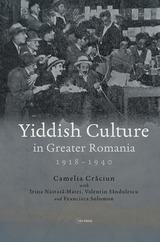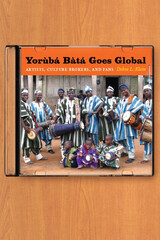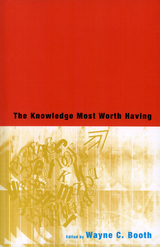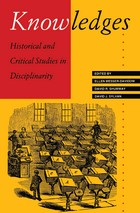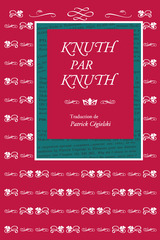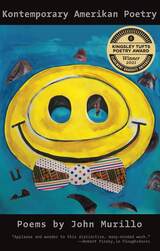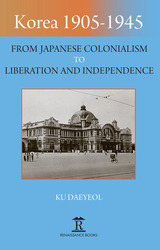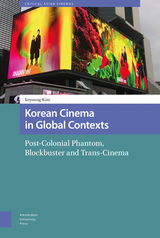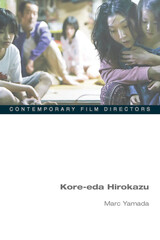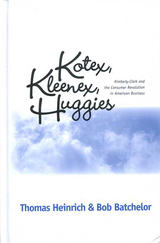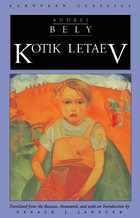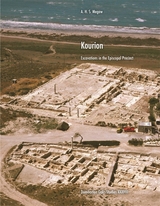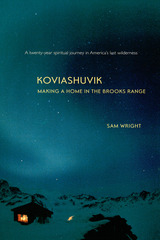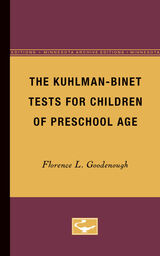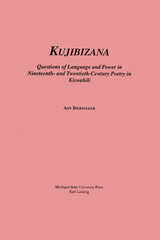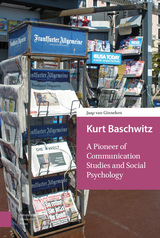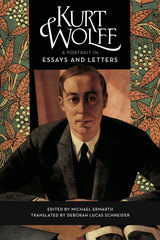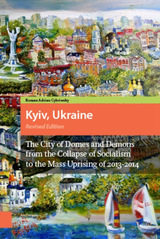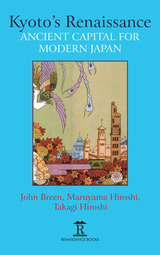The Knowledge Most Worth Having
Edited by Wayne C. Booth
University of Chicago Press, 1967 The Knowledge Most Worth Having represents the essence of education at the University of Chicago—faculty and students grappling with key intellectual questions that span the humanities, while still acknowledging the need to acquire a depth of knowledge in one’s chosen field. The papers collected here were delivered during an often-heated conference at the university in 1966, and include contributions from such scholars as Northrop Frye, Richard McKeon, and, of course, the dean of the college, Wayne Booth himself. Taken as a whole, they present a passionate defense of liberal education, one that remains highly relevant today.
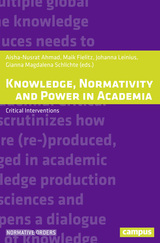 Knowledge, Normativity and Power in Academia: Critical Interventions
Edited by Aisha-Nusrat Ahmad, Maik Fielitz, Johanna Leinius and Gianna Magdalena Schlichte
Campus Verlag, 2018 Despite its capacity to produce knowledge that can directly influence policy and affect social change, academia is still often viewed as a stereotypical ivory tower, detached from the tumult of daily life. Knowledge, Normativity, and Power in Academia argues that, in our current moment of historic global unrest, the fruits of the academy need to be examined more closely than ever. This collection pinpoints the connections among researchers, activists, and artists, arguing that—despite what we might think—the knowledge produced in universities and the processes that ignite social transformation are inextricably intertwined. Knowledge, Normativity, and Power in Academia provides analysis from both inside and outside the academy to show how this seemingly staid locale can still provide space for critique and resistance.
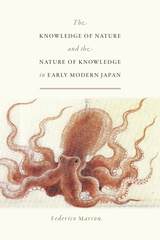 The Knowledge of Nature and the Nature of Knowledge in Early Modern Japan
Federico Marcon
University of Chicago Press, 2015 Between the early seventeenth and the mid-nineteenth century, the field of natural history in Japan separated itself from the discipline of medicine, produced knowledge that questioned the traditional religious and philosophical understandings of the world, developed into a system (called honzogaku) that rivaled Western science in complexity—and then seemingly disappeared. Or did it? In The Knowledge of Nature and the Nature of Knowledge in Early Modern Japan, Federico Marcon recounts how Japanese scholars developed a sophisticated discipline of natural history analogous to Europe’s but created independently, without direct influence, and argues convincingly that Japanese natural history succumbed to Western science not because of suppression and substitution, as scholars traditionally have contended, but by adaptation and transformation.
The first book-length English-language study devoted to the important field of honzogaku, The Knowledge of Nature and the Nature of Knowledge in Early Modern Japan will be an essential text for historians of Japanese and East Asian science, and a fascinating read for anyone interested in the development of science in the early modern era.
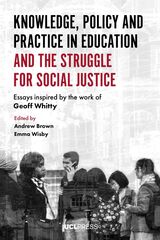 Knowledge, Policy and Practice in Education and the Struggle for Social Justice: Essays Inspired by the Work of Geoff Whitty
Edited by Andrew Brown and Emma Wisby
University College London, 2020 For 50 years, educator and sociologist Geoff Whitty resolutely pursued social justice through education, first as a classroom teacher and ultimately as the Director of the Institute of Education in London. The essays in this volume - written by some of the most influential authors in the sociology of education and critical policy studies - take Whitty’s work as the starting point from which to examine key contemporary issues in education and the challenges to social justice that they present. Set within three themes of knowledge, policy, and practice in education, the chapters tackle the issues of defining and accessing ‘legitimate’ knowledge, the changing nature of education policy under neoliberalism and globalization, and the reshaping of teacher workplaces and professionalism – as well as attempts to realize more emancipatory practice. The essays open windows on life in the sociology of education, the scholarly community of which it was part, and the facets of education policy, practice, and research that they continue to reveal and challenge in pursuit of social justice.
 Knowledge Power And Discipline: German Studies And National Identity
Pier Carlo Bontempelli
University of Minnesota Press, 2003 An essential critical history of German studies as an academic discipline German Studies has confronted many crises, as well as severe criticism and self-criticism, and yet it has managed to maintain its disciplinary system through every upheaval—the revolution of 1848, the establishment of the Second Reich in 1871, the Weimar Republic, the Nazi Third Reich, the Second World War and the reconstruction era, the creation and reunification of the two German states. Pier Carlo Bontempelli focuses on this continuity, dating back to the early nineteenth century, when the “founding fathers” of Germanistik secured its status by grounding it in a set of fixed principles, revived by each successive generation of scholars in order to legitimize their position of power—and to ensure their capacity for cultural reproduction. Using the works of Michel Foucault and Pierre Bourdieu, Bontempelli investigates the institution and principles of German Studies and critically reconstructs its history. Mindful of the mechanisms of choice and domination operating at every turn, his book exposes the repressed social and political history of German Studies.
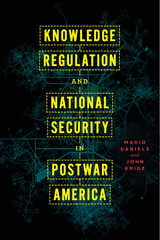 Knowledge Regulation and National Security in Postwar America
Mario Daniels and John Krige
University of Chicago Press, 2022 The first historical study of export control regulations as a tool for the sharing and withholding of knowledge.
In this groundbreaking book, Mario Daniels and John Krige set out to show the enormous political relevance that export control regulations have had for American debates about national security, foreign policy, and trade policy since 1945. Indeed, they argue that from the 1940s to today the issue of how to control the transnational movement of information has been central to the thinking and actions of the guardians of the American national security state. The expansion of control over knowledge and know-how is apparent from the increasingly systematic inclusion of universities and research institutions into a system that in the 1950s and 1960s mainly targeted business activities. As this book vividly reveals, classification was not the only—and not even the most important—regulatory instrument that came into being in the postwar era.
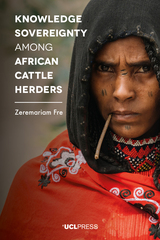 Knowledge Sovereignty Among African Cattle Herders
Zeremariam Fre
University College London, 2018 Beni-Amer cattle owners in the western part of the Horn of Africa are not only masters in cattle breeding, they are also knowledge sovereign, in terms of owning productive genes of cattle and the cognitive knowledge base crucial to sustainable development. The strong bonds between the Beni-Amer, their animals, and their environment constitute the basis of their ways of knowing, and much of their knowledge system is built on experience and embedded in their cultural practices.
In this book, the first to study Beni-Amer practices, Zeremariam Fre argues for the importance of their knowledge, challenging the preconceptions that regard it as untrustworthy when compared to scientific knowledge from more developed regions. Empirical evidence suggests that there is much one could learn from the other, since elements of pastoralist technology, such as those related to animal production and husbandry, make a direct contribution to our knowledge of livestock production. It is this potential for hybridization, as well as the resilience of the herders, at the core of the indigenous knowledge system.
Fre also argues that indigenous knowledge can be viewed as a stand-alone science, and that a community’s rights over ownership should be defended by government officials, development planners and policy makers, making the case for a celebration of the knowledge sovereignty of pastoralist communities
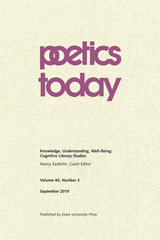 Knowledge, Understanding, Well-Being: Cognitive Literary Studies
Nancy Easterlin, special issue editor
Duke University Press Cognitive literary studies occupies a special position in debates over the purpose of higher education and the value of the humanities. Through its varied interdisciplinary commitments, cognitive literary studies offers ways to discover the processes, forms of knowledge, and ethical function of literary experience. Contributors to this issue argue that the humanities are not a trivial pursuit by theorizing and documenting the dynamic interactions of the individuals, groups, texts, and environments that cumulatively produce the forms of knowledge specific to aesthetic engagement. Hailing from psychology, communications, and literary studies, these authors represent diverse methodologies and a range of cognitive specializations, including empirical reading studies, empathy, neurophenomenology, and mindfulness psychology. Through the application of psychology to literature and literary theory, they explore the capacity of the literary humanities to enhance thought and action, whether through scholarship, teaching, mental flexibility, or human well-being.
Contributors. Marshall Alcorn, Paul B. Armstrong, Katalin Bálint, Mark Bracher, Elizabeth Bradburn, M. Soledad Caballero, Nancy Easterlin, Richard J. Gerrig, Erin James, Aimee Knupsky, Anežka Kuzmičová, Micah L. Mumper, Michael O’Neill, Margrethe Bruun Vaage, Alexa Weik von Mossner
Knowledge-based Systems for Industrial Control
J. McGhee
The Institution of Engineering and Technology, 1990 Expert and knowledge-based systems have great potential for industrial control systems, particularly in the process industries. Recognising the importance of this emerging area, the Institution of Electrical Engineers organised a Vacation School on the subject, for engineers from industry and academia, at the University of Strathclyde in September 1990.
 The Known Citizen: A History of Privacy in Modern America
Sarah E. Igo
Harvard University Press, 2020 A Washington Post Book of the Year
Winner of the Merle Curti Award
Winner of the Jacques Barzun Prize
Winner of the Ralph Waldo Emerson Award
“A masterful study of privacy.”
—Sue Halpern, New York Review of Books
“Masterful (and timely)…[A] marathon trek from Victorian propriety to social media exhibitionism…Utterly original.”
—Washington Post
Every day, we make decisions about what to share and when, how much to expose and to whom. Securing the boundary between one’s private affairs and public identity has become an urgent task of modern life. How did privacy come to loom so large in public consciousness? Sarah Igo tracks the quest for privacy from the invention of the telegraph onward, revealing enduring debates over how Americans would—and should—be known. The Known Citizen is a penetrating historical investigation with powerful lessons for our own times, when corporations, government agencies, and data miners are tracking our every move.
“A mighty effort to tell the story of modern America as a story of anxieties about privacy…Shows us that although we may feel that the threat to privacy today is unprecedented, every generation has felt that way since the introduction of the postcard.”
—Louis Menand, New Yorker
“Engaging and wide-ranging…Igo’s analysis of state surveillance from the New Deal through Watergate is remarkably thorough and insightful.”
—The Nation
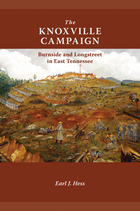 The Knoxville Campaign: Burnside and Longstreet in East Tennessee
Earl J. Hess
University of Tennessee Press, 2012 “Hess’s account of the understudied Knoxville Campaign sheds new light on the generalship of James Longstreet and Ambrose Burnside, as well as such lesser players as Micah Jenkins and Orlando Poe. Both scholars and general readers should welcome it. The scholarship is sound, the research, superb, the writing, excellent.” —Steven E. Woodworth, author of Decision in the Heartland: The Civil War in the West
In the fall and winter of 1863, Union General Ambrose Burnside and Confederate General James Longstreet vied for control of the city of Knoxville and with it the railroad that linked the Confederacy east and west. The generals and their men competed, too, for the hearts and minds of the people of East Tennessee. Often overshadowed by the fighting at Chickamauga and Chattanooga, this important campaign has never received a full scholarly treatment. In this landmark book, award-winning historian Earl J. Hess fills a gap in Civil War scholarship—a timely contribution that coincides with and commemorates the sesquicentennial of the Civil War
The East Tennessee campaign was an important part of the war in the West. It brought the conflict to Knoxville in a devastating way, forcing the Union defenders to endure two weeks of siege in worsening winter conditions. The besieging Confederates suffered equally from supply shortages, while the civilian population was caught in the middle and the town itself suffered widespread destruction. The campaign culminated in the famed attack on Fort Sanders early on the morning of November 29, 1863. The bloody repulse of Longstreet’s veterans that morning contributed significantly to the unraveling of Confederate hopes in the Western theater of operations.
Hess’s compelling account is filled with numerous maps and images that enhance the reader’s understanding of this vital campaign that tested the heart of East Tennessee. The author’s narrative and analysis will appeal to a broad audience, including general readers, seasoned scholars, and new students of Tennessee and Civil War history. The Knoxville Campaign will thoroughly reorient our view of the war as it played out in the mountains and valleys of East Tennessee.
EARL J. HESS is Stewart W. McClelland Distinguished Professor in Humanities and an associate professor of history at Lincoln Memorial University. He is the author of nearly twenty books, including The Civil War in the West—Victory and Defeat from the Appalachians to the Mississippi and Lincoln Memorial University and the Shaping of Appalachia.
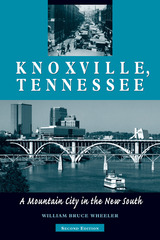 Knoxville, Tennessee: A Mountain City in the New South
William Bruce Wheeler
University of Tennessee Press, 2005 Knoxville, Tennessee: A Mountain City in the New South is much more than an update to the 1983 edition; it is virtually a complete rethinking of its predecessor as well as an updating of Knoxville’s story from the 1982 World’s Fair to the death of the nearly legendary Cas Walker.In this new edition, Wheeler argues that, like Jay Gatsby in The Great Gatsby (1925), Knoxvillians have fabricated for themselves a false history, portraying themselves and their city as the almost impotent victims of historical forces that they could neither alter nor control. The result of this myth, Wheeler says, is a collective mentality of near-helplessness against the powerful forces of isolation, poverty, and even change itself. But Knoxville’s past is far more complicated than that, for the city contained abundant material goods and human talent that could have been used to propel Knoxville into the ranks of the premier cities of the New South—if those assets had not slipped through the fingers of both the leaders and the populace. In all, Knoxville’s history is the story of colliding forces—country and city, North and South, the poor and the elite, as well as the story of colorful figures, including Perez Dickinson, Edward Sanford, George Dempster, William Yardley, Louis Brownlow, Cas Walker, Carlene Malone, Victor Ashe, and many, many more.This is not, however, a history–or a future—without hope. Wheeler charts positive changes as well, such as downtown residential movements, urban renewal initiatives, political progressivism, and improving race relations. In many ways, Knoxville’s story parallels the struggles facing all American cities, making this revised edition of interest both as a regional history and as a fascinating case study of American urbanism.William Bruce Wheeler is professor of history at the University of Tennessee, Knoxville. He is the co-author of TVA and the Tellico Dam: A Bureaucratic Crisis in Post-Industrial America and is currently at work on the sixth edition of Discovering the American Past.
 Knoxville, Tennessee: A Mountain City in the New South
William Bruce Wheeler
University of Tennessee Press, 2005 Knoxville, Tennessee: A Mountain City in the New South is much more than an update to the 1983 edition; it is virtually a complete rethinking of its predecessor as well as an updating of Knoxville’s story from the 1982 World’s Fair to the death of the nearly legendary Cas Walker. In this new edition, Wheeler argues that, like Jay Gatsby in The Great Gatsby (1925), Knoxvillians have fabricated for themselves a false history, portraying themselves and their city as the almost impotent victims of historical forces that they could neither alter nor control. The result of this myth, Wheeler says, is a collective mentality of near-helplessness against the powerful forces of isolation, poverty, and even change itself. But Knoxville’s past is far more complicated than that, for the city contained abundant material goods and human talent that could have been used to propel Knoxville into the ranks of the premier cities of the New South—if those assets had not slipped through the fingers of both the leaders and the populace. In all, Knoxville’s history is the story of colliding forces—country and city, North and South, the poor and the elite, as well as the story of colorful figures, including Perez Dickinson, Edward Sanford, George Dempster, William Yardley, Louis Brownlow, Cas Walker, Carlene Malone, Victor Ashe, and many, many more. This is not, however, a history–or a future—without hope. Wheeler charts positive changes as well, such as downtown residential movements, urban renewal initiatives, political progressivism, and improving race relations. In many ways, Knoxville’s story parallels the struggles facing all American cities, making this revised edition of interest both as a regional history and as a fascinating case study of American urbanism.
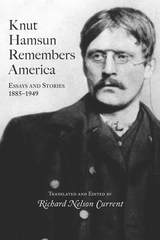 Knut Hamsun Remembers America: Essays and Stories, 1885-1949
Knut Hamsun, Edited & Translated by Richard Nelson Current
University of Missouri Press, 2003 When Americans remember him at all, they no doubt think of Knut Hamsun (1859–1952) as the author of Hunger or as the Norwegian who, along with Vidkun Quisling, betrayed his country by supporting the Nazis during World War II. Yet Hamsun, winner of the Nobel Prize in 1920 for his novel The Growth of the Soil, was and remains one of the most important and influential novelists of his time. Knut Hamsun Remembers America is a collection of thirteen essays and stories based largely on Hamsun’s experiences during the four years he spent in the United States when he was a young man. Most of these pieces have never been published before in an English translation, and none are readily available. Hamsun’s feelings about America and American ways were complex. For the most part, they were more negative than positive, and they found expression in many of his writings—directly in his reminiscences and indirectly in his fiction. In On the Cultural Life of Modern America, his first major book, he portrayed the United States as a land of gross and greedy materialism, populated by illiterates who were utterly lacking in artistic originality or refinement. Although the pieces in this collection are not all anti-American, most of them emphasize the strangeness and unpleasantness, as the author saw it, of life in what he called Yankeeland. Arranged chronologically, the pieces fall into three categories: Critical Reporting, Memory and Fantasy, and Mellow Reminiscence. The Critical Reporting section includes articles that appeared in Norwegian or Danish newspapers soon after each of Hamsun’s two visits to America and that give his views on a variety of American subjects, and includes an essay devoted to Mark Twain. Memory and Fantasy comprises narratives of life in America, most of which are presented as personal experiences but which actually are blends of fact and fiction. Mellow Reminiscence includes later and fonder recollections and impressions of the United States. The pieces in this collection provide variations on a theme that runs through much of American history—European criticism of American ways. They give vivid, at times distorted, pictures of life as it was in the United States. They tell us something about the development of the worldview of a man who became a great writer, only to jeopardize his reputation by defending the Nazi oppressors of his own people. Knut Hamsun Remembers America will appeal to anyone interested in the history of American civilization or, more specifically, in the history of anti-Americanism.
Knuth par Knuth
Donald E. Knuth
CSLI, 2020 The interviews in this volume form the nearest thing possible to an autobiography of eminent computer scientist Donald E. Knuth. Based on the English-language Companion to the Papers of Donald Knuth, also published by CSLI Publications, this book brings the highlights of that material to a Francophone audience.
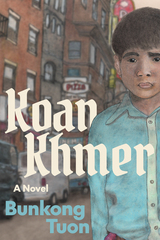 Koan Khmer: A Novel
Bunkong Tuon
Northwestern University Press, 2024 A powerful debut novel about war, immigration, and home
Celebrating the power of literature to rescue a life from despair, Koan Khmer is the story of Samnang Sok, an orphaned child survivor of the Cambodian genocide who sets out to make a new life in America alongside his extended family. Struggling to cope with the traumas of his past, Samnang feels alienated from his American peers at school and disconnected from his aunts, uncles, and cousins at home. Inspired by the books he discovers along the way, Samnang begins piecing together information about the past through stories told by elders, family photographs, and his own memories and dreams. Based loosely on Tuon’s life, the novel traces Samnang’s difficult journey toward an answer to the question, How does one rebuild a life after genocide and displacement and create a home?
Koan Khmer gives an unflinching voice to a distinctly Cambodian American sensibility. Tuon creates a refugee space that all Americans can visit in this bildungsroman that breathes life into cultural knowledge disrupted by loss and grief.
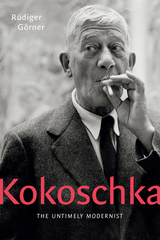 Kokoschka: The Untimely Modernist
Rüdiger Görner
Haus Publishing, 2024 The Austrian artist Oskar Kokoschka (1886–1980) achieved global fame with his intense expressionistic portraits and landscapes. In this first English-language biography, Rüdiger Görner depicts the artist in all his fascinating and contradictory complexity. He traces Kokoschka’s path from bête noire of the bourgeoisie and “hunger artist” who had to flee the Nazis to a wealthy and cosmopolitan political and critical artist who played a significant role in shaping the European art scene of the twentieth century and whose relevance is undiminished to this day. In Kokoschka: A Life in Art, Görner emphasizes the artist’s versatility. Kokoschka, although best known for his expressionistic portraits and landscapes, was more than a mere visual artist: his achievements as a playwright, essayist, and poet bear witness to a remarkable literary talent. Music, too, played a central role in his work, and a passion for teaching led him to establish in 1953 the School of Seeing, an unconventional art school intended to revive humanist ideals in the horrific aftermath of war. This biography shows brilliantly how all the pieces of Kokoschka’s disparate interests and achievements cohered in the richly creative life of a singular artist.
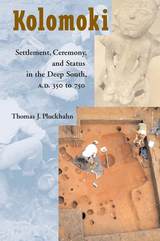 Kolomoki: Settlement, Ceremony, and Status in the Deep South, A.D. 350 to 750
Thomas J. Pluckhahn
University of Alabama Press, 2003 A Dan Josselyn Memorial Publication
The first comprehensive and systematic investigation of a Woodland period ceremonial center. Kolomoki, one of the most impressive archaeological sites in the southeastern United States, includes at least nine large earthen mounds in the lower Chattahoochee River valley of southwest Georgia. The largest, Mound A, rises approximately 20 meters above the terrace that borders it. From its flat-topped summit, a visitor can survey the string of smaller mounds that form an arc to the south and west. Archaeological research had previously placed Kolomoki within the Mississippian period (ca. A.D. 1000-1500) primarily because of the size and form of the mounds. But this book presents data for the main period of occupation and mound construction that confirm an earlier date, in the Woodland period (ca. A.D. 350-750). Even though the long-standing confusion over Kolomoki’s dating has now been settled, questions remain regarding the lifeways of its inhabitants. Thomas Pluckhahn's research has recovered evidence concerning the level of site occupation and the house styles and daily lives of its dwellers. He presents here a new, revised history of Kolomoki from its founding to its eventual abandonment, with particular attention to the economy and ceremony at the settlement. This study makes an important contribution to the understanding of middle range societies, particularly the manner in which ceremony could both level and accentuate status differentiation within them. It provides a readable overview of one of the most important but historically least understood prehistoric Native American sites in the United States.
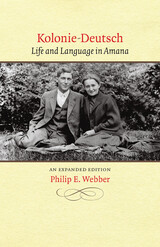 Kolonie-Deutsch: Life and Language in Amana, An Expanded Edition
Philip E. Webber
University of Iowa Press, 1993 Founded as a communal society in 1855 by German Pietists, the seven villages of Iowa’s Amana Colonies make up a community whose crafts, architecture, and institutions reflect—and to an extent perpetuate—the German heritage of earlier residents. In this intriguing blend of sociolinguistic research and stories from Colonists both past and present, Philip Webber examines the rich cultural and linguistic traditions of the Amanas. Although the Colonies are open to the outside world, particularly after the Great Change of 1932, many distinctive vestiges of earlier lifeways survive, including the local variety of German known by its speakers as Kolonie-Deutsch. Drawing upon interviews with more than fifty Amana-German speakers in 1989 and 1990, Webber explores the nuances of this home-grown German, signaling the development of local microdialects, the changing pattern in the use of German in the Colonies, and the reciprocal influence of English and German on residents’ speech. By letting his sources tell their own stories of earlier days, in which the common message seems to be wir haben fun gehabt or “we had fun working together,” he illuminates the history and unique qualities of each Colony through the prism of language study. Webber’s introduction to this paperback edition provides an up-to-date itinerary for visitors to the Colonies, information about recent publications on Amana history and culture, and an overview of expanded research opportunities for language study and historical inquiry. The result is an informative and engaging study that will be appreciated by linguists, anthropologists, and historians as well as by general readers interested in these historic villages.
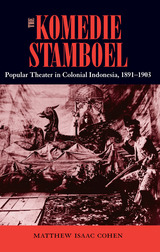 The Komedie Stamboel: Popular Theater in Colonial Indonesia, 1891–1903
Matthew Isaac Cohen
Ohio University Press, 2006 Winner of the 2008 Benda Prize
Originating in 1891 in the port city of Surabaya, the Komedie Stamboel, or Istanbul-style theater, toured colonial Indonesia, Singapore, and Malaysia by rail and steamship. The company performed musical versions of the Arabian Nights, European fairy tales and operas such as Sleeping Beauty and Aida, as well as Indian and Persian romances, Southeast Asian chronicles, true crime stories, and political allegories. The actors were primarily Eurasians, the original backers were Chinese, and audiences were made up of all races and classes. The Komedie Stamboel explores how this new hybrid theater pointed toward possibilities for the transformation of self in a colonial society and sparked debates on moral behavior and mixed-race politics.
While audiences marveled at spectacles involving white-skinned actors, there were also racial frictions between actors and financiers, sexual scandals, fights among actors and patrons, bankruptcies, imprisonments, and a murder.
Matthew Isaac Cohen's evocative social history situates the Komedie Stamboel in the culture of empire and in late nineteenth-century itinerant entertainment. He shows how the theater was used as a symbol of cross-ethnic integration in postcolonial Indonesia and as an emblem of Eurasian cultural accomplishment by Indische Nederlanders. A pioneering study of nineteenth-century Southeast Asian popular culture, The Komedie Stamboel gives a new picture of the region's arts and culture and explores the interplay of currents in global culture, theatrical innovation, and movement in colonial Indonesia.ABOUT THE AUTHOR---Matthew Isaac Cohen is senior lecturer in Drama and Theatre Studies at Royal Holloway University of London. His articles on Southeast Asian performance have appeared in New Theatre Quarterly, Asian Theatre Journal, Journal of the Royal Asiatic Society, and Archipel. As a practicing shadow puppeteer, he has performed in the United States, Europe, and Asia.
 Konduru: Structure and Integration in a South Indian Village
Paul G. Hiebert
University of Minnesota Press, 1971
Konduru was first published in 1971. Minnesota Archive Editions uses digital technology to make long-unavailable books once again accessible, and are published unaltered from the original University of Minnesota Press editions.
This is a detailed anthropological description and analysis of life in Konduru, a village in the central part of southern India about one hundred miles south of Hyderabad. The study is based on field work done by Professor Hiebert over a period of several years when he lived in the village, spoke its language, Telugu, and became closely acquainted with the people and their culture.
After sketching the geographic and historical setting of the village, Professor Hiebert describes and discusses the social structure, including the societal categories, the various castes, the social groups including family, patrilineage, associations, and communities, and hamlets, villages, and towns in the region. There are chapters on status and power, networks of interpersonal relationships, panchayats (the system of justice), and rituals. Finally, the author discusses changes which are taking place in the society and culture of Konduru and presents his conclusions. He points out that this study of Konduru illustrates the importance of the village within the social order but at the same time demonstrates that the village cannot be understood apart from the other social groups in which its members are involved and interrelated, and that these relationships are neither static nor simple. But, as he concludes, the village is, for the individual, the concrete expression of his society.
The book is illustrated with photographs, maps, and drawings. E. Adamson Hoebel, Regents' professor of anthropology at the University of Minnesota, writes a foreword.
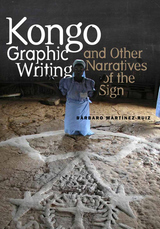 Kongo Graphic Writing and Other Narratives of the Sign
Barbaro Martinez-Ruiz
Temple University Press, 2013 Written symbols, religious objects, oral traditions, and body language have long been integrated into the Kongo system of graphic writing of the Bakongo people in Central Africa as well as their Cuban descendants. The comprehensive Kongo Graphic Writing and Other Narratives of the Sign provides a significant overview of the social, religious, and historical contexts in which the Kongo kingdom developed and spread to the Caribbean.
Author Bárbaro Martínez-Ruiz, a practitioner of the Palo Monte devotional arts, illustrates with graphics and rock art how the Bakongo’s ideographic and pictographic signs are used to organize daily life, enable interactions between humans and the natural and spiritual worlds, and preserve and transmit cosmological and cosmogonical belief systems.
Exploring cultural diffusion and exchange, collective memory and identity, Kongo Graphic Writing and Other Narratives of the Sign artfully brings together analyses of the complex interconnections among Kongo traditions of religion, philosophy and visual/gestural communication on both sides of the African Atlantic world.
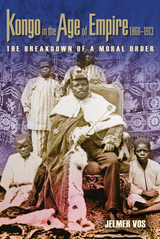 Kongo in the Age of Empire, 1860–1913: The Breakdown of a Moral Order
Jelmer Vos
University of Wisconsin Press, 2015 This richly documented account of the arrival of rubber traders, new Christian missionaries, and the Portuguese colonial state in the Kongo realm is told from the perspective of the kingdom's inhabitants. Jelmer Vos shows that both Africans and Europeans were able to forward differing social, political, and economic agendas as Kongo's sacred city of São Salvador became a vital site for the expansion of European imperialism in Central Africa. Kongo people, he argues, built on the kingdom's long familiarity with Atlantic commerce and cultures to become avid intermediaries in a new system of colonial trade and mission schools.
Vos underlines that Kongo's incorporation in the European state system also had tragic consequences, including the undermining of local African structures of authority—on which the colonial system actually depended. Kongo in the Age of Empire carefully documents the involvement of Kongo's royal court in the exercise of Portuguese rule in northern Angola and the ways that Kongo citizens experienced colonial rule as an increasingly illegitimate extension of royal power.
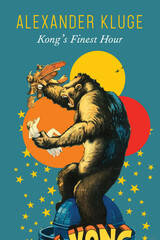 Kong's Finest Hour: A Chronicle of Connections
Alexander Kluge
Seagull Books, 2021 In a world full of devils, the giant ape Kong defends what he loves the most. But who and what is this undomesticated animal? Might it reside within us? As we tread confidently, is this where the earth opens up beneath us?
In Kong’s Finest Hour, Alexander Kluge explores anew the accessible spaces where Kong dwells within us and in our million-year-old past. The more than two hundred stories contained in this volume form a chronicle of connections that together survey these spaces using diverse perspectives. These include stories about the folds of Kong’s nose, the voice of the author’s mother, the poet Heinrich von Kleist and Jack the Ripper, the indestructability of the political, and the supercontinent Pangaea that once unified the earth. Dissolving theory into storytelling has been Kluge’s lifelong pursuit, and this magnificent collection tells stories of people as well of things.
First in a series of Kluge’s Chronicles forthcoming from Seagull Books, Kong’s Finest Hour will delight those familiar with his writing as well as introduce readers to the brilliance of one of Germany’s greatest living writers.
Kontemporary Amerikan Poetry
John Murillo
Four Way Books, 2020 John Murillo’s second book is a reflective look at the legacy of institutional, accepted violence against Blacks and Latinos and the personal and societal wreckage wrought by long histories of subjugation. A sparrow trapped in a car window evokes a mother battered by a father’s fists; a workout at an iron gym recalls a long-ago mentor who pushed the speaker “to become something unbreakable.” The presence of these and poetic forbears—Gil Scott-Heron, Yusef Komunyakaa—provide a context for strength in the face of danger and anger. At the heart of the book is a sonnet crown triggered by the shooting deaths of three Brooklyn men that becomes an extended meditation on the history of racial injustice and the notion of payback as a form of justice.
Korea 1905–1945: From Japanese Colonialism to Liberation and Independence
Ku Daeyeol
Amsterdam University Press, 2021 This important new study by one of Korea’s leading historians focuses on the international relations of colonial Korea – from the Japanese rule of the peninsula and its foreign relations (1905–1945) to the ultimate liberation of the country at the end of the Second World War. In addition, it fills a significant gap – the ‘blank space’ – in Korean diplomatic history. Furthermore, it highlights several other fundamental aspects in the history of modern Korea, such as the historical perception of the policy-making process and the attitudes of both China and Britain which influenced US policy regarding Korea at the end of World War II.
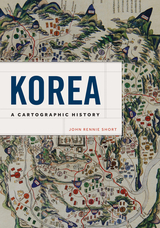 Korea: A Cartographic History
John Rennie Short
University of Chicago Press, 2012 The first general history of Korea as seen through maps, Korea: A Cartographic History provides a beautifully illustrated introduction to how Korea was and is represented cartographically. John Rennie Short, one of today’s most prolific and well-respected geographers, encapsulates six hundred years of maps made by Koreans and non-Koreans alike. Largely chronological in its organization, Korea begins by examining the differing cartographic traditions prevalent in the early Joseon period in Korea—roughly 1400 to 1600—and its temporal equivalent in early modern Europe. As one of the longest continuous dynasties, Joseon rule encompassed an enormous range and depth of cartographic production. Short then surveys the cartographic encounters from 1600 to 1900, distinguishing between the early and late Joseon periods and highlighting the influences of China, Japan, and the rest of the world on Korean cartography. In his final section, Short covers the period from Japanese colonial control of Korea to the present day and demonstrates how some of the tumultuous events of the past hundred years are recorded and contested in maps. He also explores recent cartographic controversies, including the naming of the East Sea/Sea of Japan and claims of ownership of the island of Dokdo. A common theme running throughout Short’s study is how the global flow of knowledge and ideas affects mapmaking, and Short reveals how Korean mapmakers throughout history have embodied, reflected, and even contested these foreign depictions of their homeland.
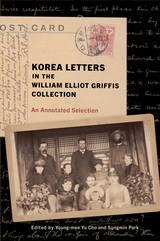 Korea Letters in the William Elliot Griffis Collection: An Annotated Selection
Young-mee Yu Cho
Rutgers University Press, 2024 William Elliot Griffis (1843 – 1928) graduated from Rutgers College in 1869 and taught four years in Fukui and Tokyo. After his return to the United States, he devoted himself to his research and writing on East Asia throughout his life. He authored 20 books about Japan and five books about Korea including, Corea: The Hermit Nation (1882), Corea, Without and Within: Chapters on Corean History, Manners and Religion (1885), The Unmannerly Tiger, and Other Korean Tales (1911), A Modern Pioneer in Korea: The Life Story of Henry G. Appenzeller (1912), and Korean Fairy Tales (1922). In particular, his bestseller, Corea: The Hermit Nation (1882) was reprinted numerous times through nine editions over thirty years. He was not only known as "the foremost interpreter of Japan to the West before World War I but also the American expert on Korea. After his death, his collection of books, documents, photographs and ephemera was donated to Rutgers.
The Korean materials in the Griffis Collection at Rutgers University consist of journals, correspondence, articles, maps, prints, photos, postcards, manuscripts, scrapbooks, and ephemera. These papers reflect Griffis's interests and activities in relation to Korea as a historian, scholar, and theologian. They provide a rare window into the turbulent period of late nineteenth- and twentieth-century Korea, witnessed and evaluated by Griffis and early American missionaries in East Asia. The Korea Letters in the William Elliot Griffis Collection are divided into two parts: letters from missionaries and letters from Japanese and Korean political figures. Newly available and accessible through this collection, these letters develop a multifaceted history of early American missionaries in Korea, the Korean independence movement, and Griffis's views on Korean culture.
 The Korean Buddhist Empire: A Transnational History, 1910–1945
Hwansoo Ilmee Kim
Harvard University Press In the first part of the twentieth century, Korean Buddhists, despite living under colonial rule, reconfigured sacred objects, festivals, urban temples, propagation—and even their own identities—to modernize and elevate Korean Buddhism. By focusing on six case studies, this book highlights the centrality of transnational relationships in the transformation of colonial Korean Buddhism.
Hwansoo Ilmee Kim examines how Korean, Japanese, and other Buddhists operating in colonial Korea, Japan, China, Taiwan, Manchuria, and beyond participated in and were significantly influenced by transnational forces, even as Buddhists of Korea and other parts of Asia were motivated by nationalist and sectarian interests. More broadly, the cases explored in the The Korean Buddhist Empire reveal that, while Japanese Buddhism exerted the most influence, Korean Buddhism was (as Japanese Buddhism was itself) deeply influenced by developments in China, Taiwan, Sri Lanka, Europe, and the United States, as well as by Christianity.
Korean Cinema in Global Contexts: Post-Colonial Phantom, Blockbuster and Trans-Cinema
Soyoung Kim
Amsterdam University Press, 2022 Offering the most comprehensive analysis of Korean cinema from its early history to the present, and including the films of Park Chan-wook, Bong Joon-ho and Kim Ki-young, Korean Cinema in Global Contexts: Postcolonial Phantom, Blockbuster and Trans-Cinema situates itself in the local, Inter-Asian, and transnational contexts by mobilizing the critical frameworks of feminism, postcolonial critique and comparative film studies. It is attentive to an enmeshment of the cinematic, aesthetics, politics and cultural history.
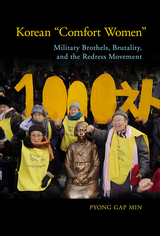 Korean "Comfort Women": Military Brothels, Brutality, and the Redress Movement
Pyong Gap Min
Rutgers University Press, 2021 Arguably the most brutal crime committed by the Japanese military during the Asia-Pacific war was the forced mobilization of 50,000 to 200,000 Asian women to military brothels to sexually serve Japanese soldiers. The majority of these women died, unable to survive the ordeal. Those survivors who came back home kept silent about their brutal experiences for about fifty years. In the late 1980s, the women’s movement in South Korea helped start the redress movement for the victims, encouraging many survivors to come forward to tell what happened to them. With these testimonies, the redress movement gained strong support from the UN, the United States, and other Western countries.
Korean “Comfort Women” synthesizes the previous major findings about Japanese military sexual slavery and legal recommendations, and provides new findings about the issues “comfort women” faced for an English-language audience. It also examines the transnational redress movement, revealing that the Japanese government has tried to conceal the crime of sexual slavery and to resolve the women’s human rights issue with diplomacy and economic power.
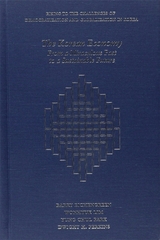 The Korean Economy: From a Miraculous Past to a Sustainable Future
Barry Eichengreen, Wonhyuk Lim, Yung Chul Park, and Dwight H. Perkins
Harvard University Press, 2017 South Korea has been held out as an economic miracle—as a country that successfully completed the transition from underdeveloped to developed country status—and as an example of how a middle-income country can continue to move up the technology ladder into the production and export of more sophisticated goods and services. But with these successes have come challenges, among them poverty, inequality, long work hours, financial instability, and complaints about the economic and political power of the country’s large corporate conglomerates, or chaebol.
The Korean Economy provides an overview of Korean economic experience since the 1950s, with a focus on the period since democratization in 1987. Successive chapters analyze the Korean experience from the perspectives of political economy, the growth record, industrial organization and corporate governance, financial development and instability, labor and employment, inequality and social policy, and Korea’s place in the world economy. A concluding chapter describes the country’s economic challenges going forward and how they can best be met. The volume also serves to summarize the findings of companion volumes in the Harvard–Korean Development Institute series on the Korean economy, also published by the Harvard University Asia Center.
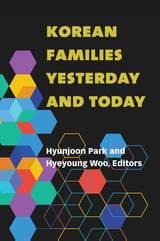 Korean Families Yesterday and Today
Hyunjoon Park and Hyeyoung Woo, Editors
University of Michigan Press, 2020 Korean families have changed significantly during the last few decades in their composition, structure, attitudes, and function. Delayed and forgone marriage, fertility decline, and rising divorce rates are just a few examples of changes that Korean families have experienced at a rapid pace, more dramatic than in many other contemporary societies. Moreover, the increase of marriages between Korean men and foreign women has further diversified Korean families. Yet traditional norms and attitudes toward gender and family continue to shape Korean men and women’s family behaviors. Korean Families Yesterday and Today portrays diverse aspects of the contemporary Korean families and, by explicitly or implicitly situating contemporary families within a comparative historical perspective, reveal how the past of Korean families evolved into their current shapes. While the study of families can be approached in many different angles, our lens focuses on families with children or young adults who are about to forge family through marriage and other means. This focus reflects that delayed marriage and declined fertility are two sweeping demographic trends in Korea, affecting family formation. Moreover, “intensive” parenting has characterized Korean young parents and therefore, examining change and persistence in parenting provides important clues for family change in Korea. This volume should be of interest not only to readers who are interested in Korea but also to those who want to understand broad family changes in East Asia in comparative perspective.
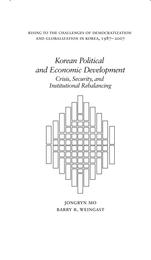 Korean Political and Economic Development: Crisis, Security, and Institutional Rebalancing
Jongryn Mo and Barry R. Weingast
Harvard University Press How do poor nations become rich, industrialized, and democratic? And what role does democracy play in this transition? To address these questions, Jongryn Mo and Barry R. Weingast study South Korea’s remarkable transformation since 1960. The authors concentrate on three critical turning points: Park Chung Hee’s creation of the development state beginning in the early 1960s, democratization in 1987, and the genesis of and reaction to the 1997 economic crisis. At each turning point, Korea took a significant step toward creating an open access social order.
The dynamics of this transition hinge on the inclusion of a wide array of citizens, rather than just a narrow elite, in economic and political activities and organizations. The political economy systems that followed each of the first two turning points lacked balance in the degree of political and economic openness and did not last. The Korean experience, therefore, suggests that a society lacking balance cannot sustain development. Korean Political and Economic Development offers a new view of how Korea was able to maintain a pro-development state with sustained growth by resolving repeated crises in favor of rebalancing and greater political and economic openness.
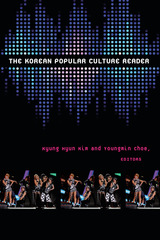 The Korean Popular Culture Reader
Kyung Hyun Kim and Youngmin Choe, eds.
Duke University Press, 2014 Over the past decade, Korean popular culture has become a global phenomenon. The "Korean Wave" of music, film, television, sports, and cuisine generates significant revenues and cultural pride in South Korea. The Korean Popular Culture Reader provides a timely and essential foundation for the study of "K-pop," relating the contemporary cultural landscape to its historical roots. The essays in this collection reveal the intimate connections of Korean popular culture, or hallyu, to the peninsula's colonial and postcolonial histories, to the nationalist projects of the military dictatorship, and to the neoliberalism of twenty-first-century South Korea. Combining translations of seminal essays by Korean scholars on topics ranging from sports to colonial-era serial fiction with new work by scholars based in fields including literary studies, film and media studies, ethnomusicology, and art history, this collection expertly navigates the social and political dynamics that have shaped Korean cultural production over the past century.
Contributors. Jung-hwan Cheon, Michelle Cho, Youngmin Choe, Steven Chung, Katarzyna J. Cwiertka, Stephen Epstein, Olga Fedorenko, Kelly Y. Jeong, Rachael Miyung Joo, Inkyu Kang, Kyu Hyun Kim, Kyung Hyun Kim, Pil Ho Kim, Boduerae Kwon, Regina Yung Lee, Sohl Lee, Jessica Likens, Roald Maliangkay, Youngju Ryu, Hyunjoon Shin, Min-Jung Son, James Turnbull, Travis Workman
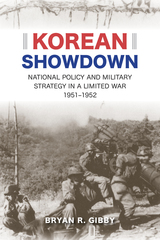 Korean Showdown: National Policy and Military Strategy in a Limited War, 1951–1952
Bryan R. Gibby
University of Alabama Press, 2021 A historical analysis of the policies and military strategies applied during the Korean War stalemate period
Winner of the 2023 Andrew F. Krepinevich Jr. Writing Award
Korean Showdown: National Policy and Military Strategy in a Limited War, 1951–1952 takes a holistic and integrative approach to strategy, operations, and tactics during the Korean War’s stalemate period and demonstrates how these matters shaped each other and influenced, or were influenced by, political and strategic policy decision-making. Bryan R. Gibby offers an analysis of the major political and military decisions affecting how the war was conducted operationally and diplomatically by examining American, Chinese, North Korean, and South Korean operations in the context of fighting a limited war with limited means, but for objectives that were not always limited in scope or ambition. The foundational political decision was Harry Truman’s voluntary repatriation policy, which extended the war by up to eighteen months. Its military counterpart was the American-led Operation Showdown, the last deliberate military offensive to coerce concessions at the negotiation table. Showdown’s failure (and the Communists’ own equally disappointing military efforts) opened up new avenues for solving the war short of a militarily imposed solution.
Gibby’s research draws on primary sources from American, Korean, and Chinese archives and publications. Many of these sources have not yet been mined in diplomatic and military histories of the Korean War. This innovative book also addresses a significant gap in the study of Korean military operations—the linkage between ground and air pressure campaigns, as well as the many Chinese and American operations conducted to establish negotiation positions. Gibby also explores many political and propagandist developments that assumed great importance in the summer of 1952, such as prisoner of war riots, the bombing of hydroelectric dams, and the South Korean constitutional crisis, which significantly influenced American and Chinese military decision-making.
Ultimately, this volume serves as a cautionary analysis of the limits of force, the necessity to understand an adversary, and the importance of strategic consensus. It also offers an effective case study on an underappreciated period of civil-military tension during the Cold War and on how civilian politicians and military leaders must collaborate to determine a realistic and effective strategy.
 The Korean Singer of Tales
Marshall R. Pihl
Harvard University Press, 1994 P'ansori, the traditional oral narrative of Korea, is sung by a highly trained soloist to the accompaniment of complex drumming. The singer both narrates the story and dramatizes all the characters, male and female. Performances require as long as six hours and make extraordinary vocal demands. In the first book-length treatment in English of this remarkable art form, Pihl traces the history of p'ansori from its roots in shamanism and folktales through its nineteenth-century heyday under highly acclaimed masters and discusses its evolution in the twentieth century. After examining the place of p'ansori in popular entertainment and its textual tradition, he analyzes the nature of texts in the repertoire and explains the vocal and rhythmic techniques required to perform them.
Pihl's superb translation of the alternately touching and comic "Song of Shim Ch'ong"—the first annotated English translation of a full p'ansori performance text—illustrates the emotional range, narrative variety, and technical complexity of p'ansori literature. The Korean Singer of Tales will interest not only Korean specialists, but also students of comparative literature, folklore, anthropology, and music.
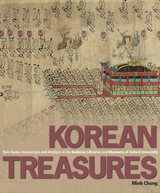 Korean Treasures: Rare Books, Manuscripts and Artefacts in the Bodleian Libraries and Museums of Oxford University
Minh Chung
Bodleian Library Publishing, 2011 The Bodleian Library and the museums of the University of Oxford are home to many historically significant and valuable manuscripts, rare books, and artifacts related to Korean history and culture. Despite their importance, many of these items have been overlooked within the libraries’ collections and largely neglected by scholars. Korean Treasures seeks to change this by highlighting the many noteworthy and unusual archaeological relics and artworks in the collections and presenting them together in a single volume for the first time. Notable items included here are the court painting scroll of the funeral procession of King Yongjo (1694–1776); a presentation edition of a book given by King Yongjo to his son-in-law; a group of documents issued by Emperor Kojong (1852–1919) between 1885–86 to confer various titles to his civil and military officials; a sundial made by the famous maker Kang Yun (1830–1898) for Emperor Kojong; a ceramic dish made and signed by Princess Yi Pangja (1901–1989) as well as a rare example of a suit of armor, an ornate helmet of the early sixteenth century, and a general’s quiver and arrows. In addition to the numerous color images of items from the collection, Korean Treasures provides a thorough overview of the extent of the Korean book collections in Oxford and a guide to the locations where some of these treasures can be found.
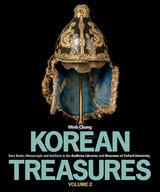 Korean Treasures Volume 2: Rare Books, Manuscripts and Artefacts in the Bodleian Libraries and Museums of Oxford University
Minh Chung
Bodleian Library Publishing, 2019 Many important and valuable rare books, manuscripts, and artifacts related to Korea have been acquired by donations throughout the long history of the Bodleian Libraries and the museums of the University of Oxford. However, due to an early lack of specialist knowledge in this area, many of these items were largely neglected at first. Following on the publication of the first volume of these forgotten treasures, this book assembles further unique and important Korean antiquities. Notable items include the only surviving Korean example of an eighteenth-century world map, hand-drawn, with a set of twelve globe gores on a single sheet, and official correspondence from the archives of the United Society for the Propagation of the Gospel, which shine a light on the history of Anglican Christian missions in Korea. Additionally, the collection boasts a wealth of photographs, coins, charms, clothing, weaponry, decorative objects, manuscripts, and much, much more.
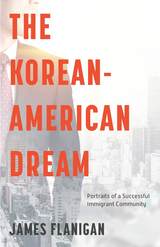 The Korean-American Dream: Portraits of a Successful Immigrant Community
James Flanigan
University of Nevada Press, 2018 Chairman Yang Ho Cho, head of Korean Air and Hanjin, talks of Los Angeles as a “microcosm of the United States—a land built of immigrants who want to do one thing: improve their lives.”
In The Korean-American Dream, respected and distinguished business journalist James Flanigan uncovers the struggles and contributions of the people who have made Los Angeles the largest Korean city outside of Seoul.
This intimate account illustrates how Korean immigrants have preserved their culture and history as well as adapted to the American culture of E Pluribus Unum, the radical promise of “out of many, one.” Flanigan shows how Los Angeles emerged as a capital of the Asia Pacific region.
At less than 2 million, Korean Americans are a relatively small group compared to new Americans from China, the Philippines, and India. But with energy and drive, they are building landmarks in New York as well as L.A., lobbying for causes in Washington, founding businesses, heading universities and hospitals, and holding public office in all parts of the U.S.
Flanigan’s compelling narrative told largely through personal interviews provides a front-row seat to the economic, business, and cultural developments of the Korean American Community. At a time of spirited debate about immigration, their energy and ambition serve as a ringing reminder of the promise of the American mosaic.
Kore-eda Hirokazu
Marc Yamada
University of Illinois Press, 2023 Films like Shoplifters and After the Storm have made Kore-eda Hirokazu one of the most acclaimed auteurs working today. Critics often see Kore-eda as a director steeped in the Japanese tradition defined by Yasujirō Ozu. Marc Yamada, however, views Kore-eda’s work in relation to the same socioeconomic concerns explored by other contemporary international filmmakers. Yamada reveals that a type of excess, not the minimalism associated with traditional aesthetics, defines Kore-eda’s trademark humanism. This excess manifests in small moments when a desire for human connection exceeds the logic of the institutions and policies formed by the neoliberal values that have shaped modern-day Japan. As Yamada shows, Kore-eda captures the shared spaces formed by bodies that move, perform, and assemble in ways that express the humanistic impulse at the core of the filmmaker’s expanding worldwide appeal.
 The Kosher Baker: Over 160 Dairy-free Recipes from Traditional to Trendy
Paula Shoyer
Brandeis University Press, 2010 Producing flavorful and appealing kosher desserts has been a challenge in Jewish households throughout the ages. Without access to butter, cream, milk, cheese, yogurt, or other dairy products, creating a tasty and memorable dessert for family and friends requires more than simple substitutions and compromises. Now pastry chef and teacher Paula Shoyer provides the inspiration and innovation to turn the age-old challenges of parve baking into delectable delights in her one-of-a-kind kosher cookbook. The Kosher Baker is your indispensable kitchen companion to a wide range of dairy-free desserts, from family favorites and time-honored holiday classics to stylish and delicious surprises of Shoyer’s own careful creation. It even includes desserts not usually found on a kosher table, such as creamy key lime pie, luscious flan, and rich tiramisu. You’ll find everything from cookies, biscotti, breads and muffins to pastries, tarts, fancy cakes, and mousses. Shoyer guides you through more than 160 mouth-watering recipes and expands every non-dairy baker’s repertoire with simple, clear instructions and a friendly yet authoritative voice. The Kosher Baker is organized as a tutorial into three primary sections—Quick and Elegant Desserts, Two Step Desserts, and Multiple Step Desserts—allowing the busy home baker to choose a dessert based on both taste and time constraints. The first section presents the fundamentals of simple kosher baking in the form of everyday treats like Amaretto Cookies, Orange Tea Cake, and Apple Pastry. The next two sections teach increasingly more challenging desserts, from a Challah Beer Bread Pudding with Caramel Sauce to Chocolate Babka. A special fourth section includes chapters on baking Challah, Passover desserts, and no-sugar-added desserts. The Kosher Baker has something for everyone in the Jewish household for any occasion or holiday. It spills over with detailed information, including tips on storage, freezing, and thawing; tools; must-have ingredients; and tips and techniques. Anyone baking for those with special dietary needs such as food allergies or diabetic concerns will also find recipes to love in this comprehensive collection. It even includes recipes for nut- and gluten-free desserts, and vegan desserts. No Jewish home should be without this essential cookbook!
 A Kosher Christmas: 'Tis the Season to be Jewish
Joshua Eli Plaut
Rutgers University Press, 2012 Christmas is not everybody’s favorite holiday. Historically, Jews in America, whether participating in or refraining from recognizing Christmas, have devised a multitude of unique strategies to respond to the holiday season. Their response is a mixed one: do we participate, try to ignore the holiday entirely, or create our own traditions and make the season an enjoyable time? This book, the first on the subject of Jews and Christmas in the United States, portrays how Jews are shaping the public and private character of Christmas by transforming December into a joyous holiday season belonging to all Americans. Creative and innovative in approaching the holiday season, these responses range from composing America’s most beloved Christmas songs, transforming Hanukkah into the Jewish Christmas, creating a national Jewish tradition of patronizing Chinese restaurants and comedy shows on Christmas Eve, volunteering at shelters and soup kitchens on Christmas Day, dressing up as Santa Claus to spread good cheer, campaigning to institute Hanukkah postal stamps, and blending holiday traditions into an interfaith hybrid celebration called “Chrismukkah” or creating a secularized holiday such as Festivus. Through these venerated traditions and alternative Christmastime rituals, Jews publicly assert and proudly proclaim their Jewish and American identities to fashion a universally shared message of joy and hope for the holiday season.
See also: http://www.akosherchristmas.org
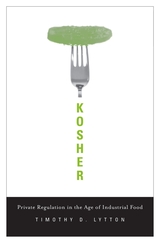 Kosher: Private Regulation in the Age of Industrial Food
Timothy D. Lytton
Harvard University Press, 2013 Generating over $12 billion in annual sales, kosher food is big business. It is also an unheralded story of successful private-sector regulation in an era of growing public concern over the government’s ability to ensure food safety. Kosher uncovers how independent certification agencies rescued American kosher supervision from fraud and corruption and turned it into a model of nongovernmental administration.
Currently, a network of over three hundred private certifiers ensures the kosher status of food for over twelve million Americans, of whom only eight percent are religious Jews. But the system was not always so reliable. At the turn of the twentieth century, kosher meat production in the United States was notorious for scandals involving price-fixing, racketeering, and even murder. Reform finally came with the rise of independent kosher certification agencies which established uniform industry standards, rigorous professional training, and institutional checks and balances to prevent mistakes and misconduct.
In overcoming many of the problems of insufficient resources and weak enforcement that hamper the government, private kosher certification holds important lessons for improving food regulation, Timothy Lytton argues. He views the popularity of kosher food as a response to a more general cultural anxiety about industrialization of the food supply. Like organic and locavore enthusiasts, a growing number of consumers see in rabbinic supervision a way to personalize today’s vastly complex, globalized system of food production.
Kosmos: Course of Six Lectures on the Development of our Inisght into the Structure of the Universe, Delivered for the Lowell Institute in Boston, in November 1931
Willem de Sitter
Harvard University Press One of the leading astronomers of our time has here explained in non-technical language what his science is about. His method has been to discuss what each of the great astronomers has contributed to our knowledge of the universe, from the earliest Greek star-gazers down to Eddington, Jeans, and Einstein. He thus gives both a history of astronomy and an account of its purposes and its ways of working. The basis of the book is the series of Lowell Institute Lectures which Professor De Sitter delivered before popular audiences last winter; his development of those Lectures has been calculated to make his material even more informative to the general reader.
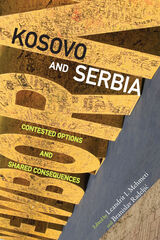 Kosovo and Serbia: Contested Options and Shared Consequences
Leandrit I. Mehmeti
University of Pittsburgh Press, 2016 Following the 1992 breakup of Yugoslavia, the region descended into a series of bloody conflicts marked by intense ethnic and religious hatreds. Kosovo emerged at the epicenter of these disputes and the site of innumerable human rights violations, as Serbia, united with Montenegro at the time, sought to remove the Albanian presence. Kosovo (roughly ninety percent Albanian) declared independence in 2008, and although it is recognized by over one hundred UN member states, it is still not recognized by Serbia.
This volume brings together scholars of Serbian, Albanian, Christian, and Muslim backgrounds to examine the Serbian-Albanian dynamic in Kosovo through historical, political, economic, and social perspectives. The contributors offer fresh insights on the consequences of internationalizing the conflict, the impact of international agencies and institutions since the 1999 intervention, the continuing human rights violations, present day party politics, and the prospects for economic cooperation with Serbia, among other topics. Kosovo and Serbia will inform scholars and students of the region, exploring the nature of a tragic political and strategic struggle that has existed for centuries and drawn the attention of the entire international community.
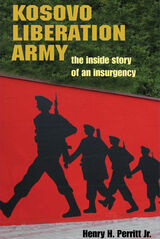 Kosovo Liberation Army: The Inside Story of an Insurgency
Henry H. Perritt Jr.
University of Illinois Press, 2008 The military intervention by NATO in Kosovo was portrayed in American media as a necessary step to prevent the Serbian armed forces from repeating the ethnic cleansing that had so deeply damaged the former Yugoslavia. Serbia trained its military on Kosovo because of an ongoing armed struggle by ethnic Albanians to wrest independence from Serbia. Warfare in the Balkans seemed to threaten the stability of Europe, as well as the peace and security of Kosovars, and yet armed resistance seemed to offer the only possibility of future stability. Leading the struggle against Serbia was the Kosovo Liberation Army, also known as the KLA. Kosovo Liberation Army: The Inside Story of an Insurgency provides a historical background for the KLA and describes its activities up to and including the NATO intervention. Henry H. Perritt Jr. offers firsthand insight into the motives and organization of a popular insurgency, detailing the strategies of recruitment, training, and financing that made the KLA one of the most successful insurgencies of the post-cold war era. This volume also tells the personal stories of young people who took up guns in response to repeated humiliation by "foreign occupiers," as they perceived the Serb police and intelligence personnel. Perritt illuminates the factors that led to the KLA's success, including its convergence with political developments in eastern Europe, its campaign for popular support both at home and abroad, and its participation in international negotiations and a peace settlement that helped pave the long road from war to peace.
Kotik Letaev
Andrei Bely
Northwestern University Press, 1999 One of the most important works of twentieth-century Russian prose, Kotik Letaev, the great symbolist novel of childhood, depicts the emergence of consciousness and its development into self-consciousness in a Russian boy growing up among the Moscow intelligentsia in the 1800s.
Kotik's experience is based on elements from Bely's own early childhood, but on a larger level his experience represents the stages of human history, the history of philosophy, and childhood language development. The story, seen through the eyes of a child from the age of three to five years, is told in complex, poetically developed adult language, rich in imagery and musical sound effects.
Kourion: Excavations in the Episcopal Precinct
A. H. S. Megaw
Harvard University Press, 2007 More than fifty years after the earthquake of 365 destroyed Kourion, the seat of the Roman administration of Cyprus, a Christian basilica was built upon the remains of its pagan predecessor. This basilica became the center of a large complex that included a baptistery, atrium, and numerous other structures and buildings. Replete with mosaics and revetment, the Christian basilica was the center of the ecclesiastical administration of Cyprus until its destruction in the late seventh century. In this long-awaited report, A. H. S. Megaw and colleagues present in full the results of excavations from the 1930s, 1950s, and 1970s. In addition to the stratigraphic history of the complex, there are reports on the mosaics, revetment, sculpture, coins, inscriptions, glass, pottery, lamps, and small finds.
Koviashuvik: Making a Home in the Brooks Range
Sam Wright
University of Arizona Press, 1997 On a slope above a mountain lake in Alaska’s Brooks Range, Sam and Billie Wright built a twelve-by-twelve-foot log cabin with hand tools and named it Koviashuvik—an Eskimo word meaning "living in the present moment with quiet joy and happiness." Sam’s account of the twenty years they spent there is both a tale of wilderness survival and an inspiring meditation on the natural world and humanity’s relationship to it.
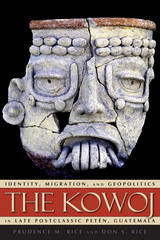 The Kowoj: Identity, Migration, and Geopolitics in Late Postclassic Petén, Guatemala
Prudence M. Rice
University Press of Colorado, 2009 Neighbors of the better-known Itza in the central Petén lakes region of Guatemala, the Kowoj Maya have been studied for little more than a decade. The Kowoj: Identity, Migration, and Geopolitics in Late Postclassic Petén, Guatemala summarizes the results of recent research into this ethno-political group conducted by Prudence Rice, Don Rice, and their colleagues. Chapters in The Kowoj address the question "Who are the Kowoj?" from varied viewpoints: archaeological, archival, linguistic, ethnographic, and bioarchaeological. Using data drawn primarily from the peninsular site of Zacpetén, the authors illuminate Kowoj history, ritual components of their self-expressed identity, and their archaeological identification. These data support the Kowoj claim of migration from Mayapán in Yucatán, where they were probably affiliated with the Xiw, in opposition to the Itza. These enmities extended into Petén, culminating in civil warfare by the time of final Spanish conquest in 1697. The first volume to consider Postclassic Petén from broadly integrative anthropological, archaeological, and historical perspectives, The Kowoj is an important addition to the literature on late Maya culture and history in the southern lowlands. It will be of particular interest to archaeologists, historians, ethnohistorians, art historians, and epigraphers.
Kpele Lala: Ga Religious Songs and Symbols
Marion Kilson
Harvard University Press, 1971 The Ga of southeastern Ghana believe that kpele cult represents the religion of their forefathers. Here is the collection of more than 240 of the song texts (lala) of this cult, each accompanied by its English translation. Marion Kilson’s introductory essay delves into the complex Ga conceptualization of the universe that underlies the songs and sets them in the context of Ga social organization.
 K-Pop Fandom: Performing Deokhu from the 1990s to Today
Areum Jeong
University of Michigan Press, 2026 K-Pop Fandom insists that K-pop fan practices and activities constitute a central productive force, shaping not only K-pop’s explosive global popularity, but also K-pop’s cultural impacts, politics, and horizons of possibility. Over the past three decades, the K-pop fandom and its activities have expanded, intensified, and diversified along myriad dimensions, assuming novel social, technological, and economic forms, some of which are unique to K-pop, and some of which reflect broader cultural and industrial logics of globalized mass entertainment culture. Areum Jeong argues that K-pop fans, in performing deokhu—a Korean term connoting an “avid fan”—perform a materialization of affective labor that also seeks to produce good relationships between asymmetrically positioned actors in the K-pop ecosystem.
Through an autoethnography of becoming a K-pop deokhu, Jeong connects their experiences to generations of K-pop fans, showing simultaneously how fandom practices have shifted over time and the intricacies of fan labor participation. This personal connection paved the way for participant-observation and co-performer witnessing methodologies in the study, which crucially allowed for collaborating with fans whose communal pursuits have been stigmatized by dominant discourses that denigrate their activities as solely addictive, uncritical, and wasteful. Jeong’s genre-spanning corpus of fan activities and analyzing its contexts and contents represents an important contribution to the making of a fan archive that is also an archive of affective labor.
 Kracauer. Photographic Archive
Edited by Maria Zinfert
Diaphanes, 2014 Siegfried Kracauer was a leading figure on the Weimar arts scene and one of the foremost representatives of the Frankfurt School of critical theory. Best known for a wealth of writings on sociology and film theory, his influence is felt in the work of many of the period’s preeminent thinkers, including the critic Theodor W. Adorno, who once claimed he owed more to Kracauer than any other intellectual.
Kracauer.Photographic Archive, a companion volume to The Past’s Threshold: Essays on Photography, collects previously unpublished photographs by Siegfried and Elisabeth, “Lili,” Kracauer. With its remarkably rich material, the book tells the story of the Kracauer’s close working relationship, from their marriage in Germany to their escape to Paris and the war and postwar years in the United States. While neither Kracauer nor his wife trained in photography, their portraits, city views, and landscapes evince impressive aesthetic and technical skill, while simultaneously shedding light on their lives marked by exile and flight.
 Krakatau: The Destruction and Reassembly of an Island Ecosystem
Ian Thornton
Harvard University Press, 1996 After the eruption, Krakatau provided a unique opportunity to study the colonization of a sterile area by plants and animals across a sea barrier and the gradual incorporation of the newcomers into the developing ecosystem. Krakatau is a comprehensive account of the reassembly of a tropical forest ecosystem over the past century. Ian Thornton tackles the many questions and controversies surrounding the eruption and its aftermath. He writes, “The natural healing process has followed the most extreme form of ecological destruction possible, total biological extirpation. Yet the islands surviving the 1883 eruption are covered in secondary forest, and over 200 species of plants, 70 species of vertebrates, and thousands of invertebrate species now inhabit these forests.”
Krakatau will be essential reading for anyone who wishes to understand not just the rebirth of Krakatau but also the resilient nature of life everywhere.
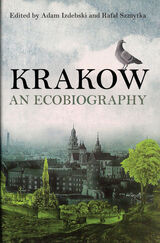 Krakow: An Ecobiography
Adam Izdebski
University of Pittsburgh Press, 2020 Like most cities, Poland’s Kraków developed around and because of its favorable geography. Before Warsaw, Kraków served as Poland’s capital for half a millennium. It has functioned as a cultural center, an industrial center, a center of learning, and home for millions of people. Behind all of this lies the city’s environment: its fauna and plant life, the Vistula River, the surrounding countryside rich with resources, and man-made change that has allowed the city to flourish. In Kraków: An Ecobiography, the contributors use the city as a lens to focus these social and natural intricacies to shed new light on one of Europe’s urban treasures. With chapters on pollution, water systems, the city’s natural network with the surrounding area, urban infrastructure, and more, Kraków demonstrates how much an environmental perspective can bring to the understanding of Poland’s history and the challenges presented by the heritage of the past.
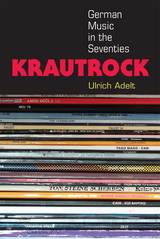 Krautrock: German Music in the Seventies
Ulrich Adelt
University of Michigan Press, 2016 Krautrock is a catch-all term for the music of various white German rock groups of the 1970s that blended influences of African American and Anglo-American music with the experimental and electronic music of European composers. Groups such as Can, Popol Vuh, Faust, and Tangerine Dream arose out of the German student movement of 1968 and connected leftist political activism with experimental rock music and, later, electronic sounds. Since the 1970s, American and British popular genres such as indie, post-rock, techno, and hip-hop have drawn heavily on krautrock, ironically reversing a flow of influence krautrock originally set out to disrupt.
Among other topics, individual chapters of the book focus on the redefinition of German identity in the music of Kraftwerk, Can, and Neu!; on community and conflict in the music of Amon Düül, Faust, and Ton Steine Scherben; on “cosmic music” and New Age; and on Donna Summer’s and David Bowie’s connections to Germany. Rather than providing a purely musicological or historical account, Krautrock discusses the music as being constructed through performance and articulated through various forms of expressive culture, including communal living, spirituality, and sound.
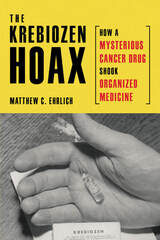 The Krebiozen Hoax: How a Mysterious Cancer Drug Shook Organized Medicine
Matthew C. Ehrlich
University of Illinois Press, 2024 The brainchild of an obscure Yugoslav physician, Krebiozen emerged in 1951 as an alleged cancer treatment. Andrew Ivy, a University of Illinois vice president and a famed physiologist dubbed “the conscience of U.S. science,” wholeheartedly embraced Krebiozen. Ivy’s impeccable credentials and reputation made the treatment seem like another midcentury medical miracle. But after years of controversy, the improbable saga ended with Krebiozen proved a sham, its inventor fleeing the country, and Ivy’s reputation and legacy in ruins. Matthew C. Ehrlich’s history of Krebiozen tells a quintessential story of quackery. Though most experts dismissed the treatment, it found passionate public support not only among cancer patients but also people in good health. The treatment’s rise and fall took place against the backdrop of America’s never-ending suspicion of educational, scientific, and medical expertise. In addition, Ehrlich examines why people readily believe misinformation and struggle to maintain hope in the face of grave threats to well-being. A dramatic account of fraud and misplaced trust, The Krebiozen Hoax shines a light on a forgotten medical scandal and its all-too-familiar relevance in the twenty-first century.
 Kree: A Post-Exotic Novel
draeger
University of Minnesota Press, 2024 A warrior struggles through an apocalyptic landscape and the world after death
Kree Toronto has been raised as a warrior in a ravaged world: postapocalyptic, posthuman, the population decimated by wars and civilization long since collapsed. After her attempt to avenge the death of her dog, Loka, goes horribly wrong, Kree finds herself lost in a world after death and wanders into the city of the terrible mendicants. Under the Brothers’ totalitarian rule, Kree can lead a quiet life and forget her violent past, even if needles grow in her skull and hallucinatory blood rains pour down now and then to remind her. She can make friends: a shamanic healer with a shaking tent, a mysterious stranger hatched from an egg, and a gruff Tibetan electrician in a world without electricity. And she can have her Loka as long as she toes the Party line and does as she’s told. When she can’t—when her friends start to disappear and the Brothers turn against her—Kree sets out on a quest, searching for a new way forward. Multiply reincarnated and unstuck in time, Kree is the characteristically marvelous creation of Manuela Draeger, whose extraordinary stories, in the words of author China Miéville, “are as close to dreams as fiction can be.”
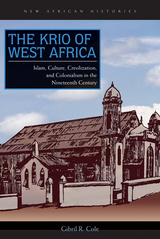 The Krio of West Africa: Islam, Culture, Creolization, and Colonialism in the Nineteenth Century
Gibril R. Cole
Ohio University Press, 2013 Sierra Leone’s unique history, especially in the development and consolidation of British colonialism in West Africa, has made it an important site of historical investigation since the 1950s. Much of the scholarship produced in subsequent decades has focused on the “Krio,” descendants of freed slaves from the West Indies, North America, England, and other areas of West Africa, who settled Freetown, beginning in the late eighteenth century. Two foundational and enduring assumptions have characterized this historiography: the concepts of “Creole” and “Krio” are virtually interchangeable; and the community to which these terms apply was and is largely self-contained, Christian, and English in worldview. In a bold challenge to the long-standing historiography on Sierra Leone, Gibril Cole carefully disentangles “Krio” from “Creole,” revealing the diversity and permeability of a community that included many who, in fact, were not Christian. In Cole’s persuasive and engaging analysis, Muslim settlers take center stage as critical actors in the dynamic growth of Freetown’s Krio society. The Krio of West Africa represents the results of some of the first sustained historical research to be undertaken since the end of Sierra Leone’s brutal civil war. It speaks clearly and powerfully not only to those with an interest in the specific history of Sierra Leone, but to histories of Islam in West Africa, the British empire, the Black Atlantic, the Yoruban diaspora, and the slave trade and its aftermath.
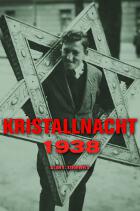 Kristallnacht 1938
Alan E. Steinweis
Harvard University Press, 2009 On November 7, 1938, a Jewish teenager, Herschel Grynszpan, fatally shot a German diplomat in Paris. Within three days anti-Jewish violence erupted throughout Germany, initially incited by local Nazi officials, and ultimately sanctioned by the decisions of Hitler and Goebbels at the pinnacle of the Third Reich. As synagogues burned and Jews were beaten in the streets, police stood aside. Men, women, and children—many neighbors of the victims—participated enthusiastically in acts of violence, rituals of humiliation, and looting. By the night of November 10, a nationwide antisemitic pogrom had inflicted massive destruction on synagogues, Jewish schools, and Jewish-owned businesses. During and after this spasm of violence and plunder, 30,000 Jewish men were rounded up and sent to concentration camps, where hundreds would perish in the following months.
Kristallnacht revealed to the world the intent and extent of Nazi Judeophobia. However, it was seen essentially as the work of the Nazi leadership. Now, Alan Steinweis counters that view in his vision of Kristallnacht as a veritable pogrom—a popular cathartic convulsion of antisemitic violence that was manipulated from above but executed from below by large numbers of ordinary Germans rioting in the streets, heckling and taunting Jews, cheering Stormtroopers' hostility, and looting Jewish property on a massive scale.
Based on original research in the trials of the pogrom's perpetrators and the testimonies of its Jewish survivors, Steinweis brings to light the evidence of mob action by all sectors of the civilian population. Kristallnacht 1938 reveals the true depth and nature of popular antisemitism in Nazi Germany on the eve of the Holocaust.
 The Krobo People of Ghana to 1892: A Political and Social History
Louis E. Wilson
Ohio University Press, 1991 This book presents a broad analytical framework for the history of southeastern Ghana within the context of a representative study of one of the country’s most important political and economic forces. The 150,000 Krobo are the most numerous of the Adangme-speaking peoples. They are located in the mountains just inland from the coast and are the fourth largest ethnic group in the country. During the nineteenth century they were one of the small states of the Gold Coast in the formative stages of political and cultural development. After the middle of the nineteenth century they became economically and politically one of the most important groups in the country because of their dominant role in commercial production of export crops. Historical research on Ghana has produced mostly case studies of the large, centralized Akan states. Wilson’s study is an account of one of the smaller societies without which a history of Ghana would be incomplete.
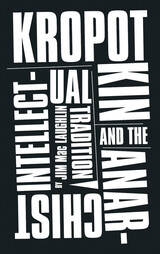 Kropotkin and the Anarchist Intellectual Tradition
Jim MacLaughlin
Pluto Press, 2015 Activist, economist, geographer, evolutionary theorist, and philosopher Peter Kropotkin remains one of the most important and progressive anarchist theorists, pushing anarchist thought beyond an individualist model to a theory of communal anarchism. Kropotkin and the Anarchist Intellectual Tradition seeks to rescue Kropotkin’s philosophy of anarchism from the neglect that it has suffered at the hands of mainstream histories of the social and environmental sciences. Jim Mac Laughlin provides a sustained and critical reading of Kropotkin’s extensive writings on the social, historical, and scientific basis of modern anarchism, giving a thorough examination of a number of key themes in Kropotkin’s philosophy, including his concerted efforts to provide anarchism with an historical and scientific basis; the role of mutualism and mutual aid in social evolution and natural history; the ethics of anarchism, including the ethics of scientific research; and the anarchist critique of state-centered nationalism and other expressions of power politics.
Krúdy's Chronicles: Turn-of-the-Century Hungary in Gyula Krudy's Journalism
John Batki
Central European University Press, 2000 Written during the 1910s '20s and '30s, these articles offer a wistful and nostalgic image of the waning years of the Austro-Hungarian empire, with portraits of the Habsburgs, culminating in first-hand reports in 1916, from Vienna on the funeral of Emperor Francis Joseph I, and from Budapest on the coronation of Charles IV, the last king of Hungary. Krúdy's reports follow the bloodless democratic revolution of 1918, the Károlyi government and the short-lived Soviet Republic, and present cameos of the leading political figures of the day such as Ferenc Kossuth, Mihály Károlyi and Béla Kun.
In his lively, casual pieces Krúdy displays his intimate knowledge of Hungarian society with a special emphasis on literature and publishing.
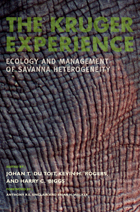 The Kruger Experience: Ecology And Management Of Savanna Heterogeneity
Edited by Johan T. du Toit, Kevin H. Rogers, and Harry C. Biggs
Island Press, 2003 Kruger National Park in South Africa has one of the most extensive sets of records of any protected area in the world, and throughout its history has supported connections between science and management. In recognition of that long-standing tradition comes The Kruger Experience, the first book to synthesize/summarize a century of ecological research and management in two million hectares of African savanna. The Kruger Experience places the scientific and management experience in Kruger within the framework of modern ecological theory and its practical applications. The book uses a cross-cutting theme of ecological heterogeneity -- the idea that ecological systems function across a full hierarchy of physical and biological components, processes, and scales, in a dynamic space-time mosaic. Contributors, who include many esteemed ecologists who have worked in Kruger in recent years, examine a range of topics covering broad taxonomic groupings and ecological processes. The book's four sections explore: - the historical context of research and management in Kruger, the theme of heterogeneity, and the current philosophy in Kruger for linking science with management
- the template of natural components and processes, as influenced by management, that determine the present state of the Kruger ecosystem
- how species interact within the ecosystem to generate further heterogeneity across space and time
- humans as key components of savanna ecosystems
In addition to the editors, contributors include William J. Bond, Jane Lubchenco, David Mabunda, Michael G.L. ("Gus") Mills, Robert J. Naiman, Norman Owen-Smith, Steward T.A. Pickett, Stuart L. Pimm, and Rober J. Scholes. The book is an invaluable new resource for scientists and managers involved with large, conserved ecosystems as well as for conservation practitioners and others with interests in adaptive management, the societal context of conservation, links between research and management in parks, and parks/academic partnerships.
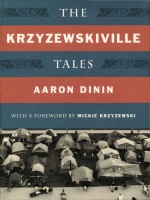 The Krzyzewskiville Tales
Aaron Dinin
Duke University Press, 2005 Recent Duke University graduate Aaron Dinin has produced an entertaining, imaginative look at Krzyzewskiville, the tent city named after Duke University's head men's basketball coach Mike Krzyzewski (Sha-shef-ski). A unique Duke tradition, Krzyzewskiville is used to determine which students are admitted into key games. Taking Geoffrey Chaucer's Canterbury Tales as his model, Dinin has created characters who narrate their semifictionalized tales—by turns reverent, bawdy, and humorous—to enlighten readers about this cherished institution. So the story begins. On a wintry night in Durham, North Carolina, writes Dinin, twelve students huddle under the meager protection of a nylon tent. They have little in common except the sacrosanct tradition that has brought them together for the past month. Before the sun next sets, they will anoint themselves in blue and white paint and enter nearby Cameron Indoor Stadium to worship at the altar of Blue Devils basketball. In the meantime, they abide in Krzyzewskiville. A stranger enters the tent, a respected sportswriter, and suggests that the tenters pass the hours until the next tent check by telling stories of Krzyzewskiville. Like Chaucer’s pilgrims, the students compete to tell the best tale. They report on ribald tenting exploits, relate a dream in which Duke basketball players and coaches test a fan’s loyalty, debate the rationality of tenting as a way of allocating students’ tickets, and describe the spontaneous tent city that sprang up one summer when their beloved “Coach K” was offered a job elsewhere. This storytelling competition creates a loving portrait of the complex rules and tribal customs that make up the rich community and loyal fans that are Krzyzewskiville. Mickie Krzyzewski, Coach K’s wife and a familiar courtside figure at Duke basketball games, has contributed a foreword praising the “love, commitment, and ownership” of the citizens of Krzyzewskiville.
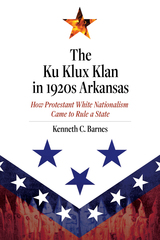 The Ku Klux Klan in 1920s Arkansas: How Protestant White Nationalism Came to Rule a State
Kenneth C. Barnes
University of Arkansas Press, 2021 Winner, 2022 J.G. Ragsdale Book Award, Arkansas Historical Association
The Ku Klux Klan established a significant foothold in Arkansas in the 1920s, boasting more than 150 state chapters and tens of thousands of members at its zenith. Propelled by the prominence of state leaders such as Grand Dragon James Comer and head of Women of the KKK Robbie Gill Comer, the Klan established Little Rock as a seat of power second only to Atlanta. In The Ku Klux Klan in 1920s Arkansas, Kenneth C. Barnes traces this explosion of white nationalism and its impact on the state’s development. Barnes shows that the Klan seemed to wield power everywhere in 1920s Arkansas. Klansmen led businesses and held elected offices and prominent roles in legal, medical, and religious institutions, while the women of the Klan supported rallies and charitable activities and planned social gatherings where cross burnings were regular occurrences. Inside their organization, Klan members bonded during picnic barbeques and parades and over shared religious traditions. Outside of it, they united to direct armed threats, merciless physical brutality, and torrents of hateful rhetoric against individuals who did not conform to their exclusionary vision. By the mid-1920s, internal divisions, scandals, and an overzealous attempt to dominate local and state elections caused Arkansas’s Klan to fall apart nearly as quickly as it had risen. Yet as the organization dissolved and the formal trappings of its flamboyant presence receded, the attitudes the Klan embraced never fully disappeared. In documenting this history, Barnes shows how the Klan’s early success still casts a long shadow on the state to this day.
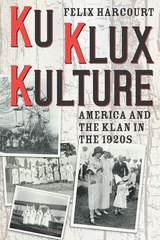 Ku Klux Kulture: America and the Klan in the 1920s
Felix Harcourt
University of Chicago Press, 2017 In popular understanding, the Ku Klux Klan is a hateful white supremacist organization. In Ku Klux Kulture, Felix Harcourt argues that in the 1920s the self-proclaimed Invisible Empire had an even wider significance as a cultural movement.
Ku Klux Kulture reveals the extent to which the KKK participated in and penetrated popular American culture, reaching far beyond its paying membership to become part of modern American society. The Klan owned radio stations, newspapers, and sports teams, and its members created popular films, pulp novels, music, and more. Harcourt shows how the Klan’s racist and nativist ideology became subsumed in sunnier popular portrayals of heroic vigilantism. In the process he challenges prevailing depictions of the 1920s, which may be best understood not as the Jazz Age or the Age of Prohibition, but as the Age of the Klan. Ku Klux Kulture gives us an unsettling glimpse into the past, arguing that the Klan did not die so much as melt into America’s prevailing culture.
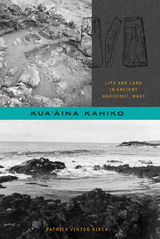 Kua'aina Kahiko: Life and Land in Ancient Kahikinui, Maui
Patrick Vinton Kirch
University of Hawaii Press, 2014 In early Hawai‘i, kua‘āina were the hinterlands inhabited by nā kua‘āina, or country folk. Often these were dry, less desirable areas where much skill and hard work were required to wrest a living from the lava landscapes. The ancient district of Kahikinui in southeast Maui is such a kua‘āina and remains one of the largest tracts of undeveloped land in the islands. Named after Tahiti Nui in the Polynesian homeland, its thousands of pristine acres house a treasure trove of archaeological ruins—witnesses to the generations of Hawaiians who made this land their home before it was abandoned in the late nineteenth century.
Kua‘āina Kahiko follows kama‘āina archaeologist Patrick Vinton Kirch on a seventeen-year-long research odyssey to rediscover the ancient patterns of life and land in Kahikinui. Through painstaking archaeological survey and detailed excavations, Kirch and his students uncovered thousands of previously undocumented ruins of houses, trails, agricultural fields, shrines, and temples. Kirch describes how, beginning in the early fifteenth century, Native Hawaiians began to permanently inhabit the rocky lands along the vast southern slope of Haleakalā. Eventually these planters transformed Kahikinui into what has been called the greatest continuous zone of dryland planting in the Hawaiian Islands. He relates other fascinating aspects of life in ancient Kahikinui, such as the capture and use of winter rains to create small wet-farming zones, and decodes the complex system of heiau, showing how the orientations of different temple sites provide clues to the gods to whom they were dedicated.
Kirch examines the sweeping changes that transformed Kahikinui after European contact, including how some maka'āinana families fell victim to unscrupulous land agents. But also woven throughout the book is the saga of Ka ‘Ohana o Kahikinui, a grass-roots group of Native Hawaiians who successfully struggled to regain access to these Hawaiian lands. Rich with ancedotes of Kirch’s personal experiences over years of field research, Kua'āina Kahiko takes the reader into the little-known world of the ancient kua‘āina.
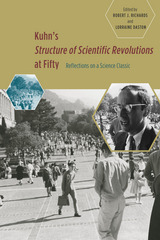 Kuhn's 'Structure of Scientific Revolutions' at Fifty: Reflections on a Science Classic
Edited by Robert J. Richards and Lorraine Daston
University of Chicago Press, 2016 Thomas S. Kuhn’s The Structure of Scientific Revolutions was a watershed event when it was published in 1962, upending the previous understanding of science as a slow, logical accumulation of facts and introducing, with the concept of the “paradigm shift,” social and psychological considerations into the heart of the scientific process. More than fifty years after its publication, Kuhn’s work continues to influence thinkers in a wide range of fields, including scientists, historians, and sociologists. It is clear that The Structure of Scientific Revolutions itself marks no less of a paradigm shift than those it describes.
In Kuhn’s “Structure of Scientific Revolutions” at Fifty, leading social scientists and philosophers explore the origins of Kuhn’s masterwork and its legacy fifty years on. These essays exhume important historical context for Kuhn’s work, critically analyzing its foundations in twentieth-century science, politics, and Kuhn’s own intellectual biography: his experiences as a physics graduate student, his close relationship with psychologists before and after the publication of Structure, and the Cold War framework of terms such as “world view” and “paradigm.”
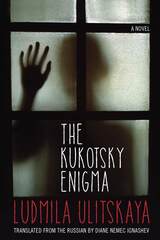 The Kukotsky Enigma: A Novel
Ludmila Ulitskaya; Translated from the Russian by Diane Nemec Ignashev
Northwestern University Press, 2016 Translated from the Russian by Diane Nemec Ignashev The central character in Ludmila Ulitskaya’s celebrated novel The Kukotsky Enigma is a gynecologist contending with Stalin’s prohibition of abortions in 1936. But, in the tradition of Russia’s great family novels, the story encompasses the history of two families and unfolds in Moscow, St. Petersburg, and the ruins of ancient civilizations on the Black Sea. Their lives raise profound questions about family heritage and genetics, nurture and nature, and life and death. In his struggle to maintain his professional integrity and to keep his work from dividing his family, Kukotsky confronts the moral complexity of reproductive science. Winner of the 2001 Russian Booker Prize and the basis for a blockbuster television miniseries, The Kukotsky Enigma is an engrossing, searching novel by one of contemporary literature’s most brilliant writers.
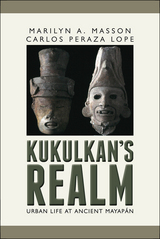 Kukulcan's Realm: Urban Life at Ancient Mayapán
Marilyn Masson
University Press of Colorado, 2014 Kukulcan's Realm chronicles the fabric of socioeconomic relationships and religious practice that bound the Postclassic Maya city of Mayapán's urban residents together for nearly three centuries. Presenting results of ten years of household archaeology at the city, including field research and laboratory analysis, the book discusses the social, political, economic, and ideological makeup of this complex urban center. Masson and Peraza Lope's detailed overview provides evidence of a vibrant market economy that played a critical role in the city's political and economic success. They offer new perspectives from the homes of governing elites, secondary administrators, affluent artisans, and poorer members of the service industries. Household occupational specialists depended on regional trade for basic provisions that were essential to crafting industries, sustenance, and quality of life. Settlement patterns reveal intricate relationships of households with neighbors, garden plots, cultivable fields, thoroughfares, and resources. Urban planning endeavored to unite the cityscape and to integrate a pluralistic populace that derived from hometowns across the Yucatán peninsula. New data from Mayapán, the pinnacle of Postclassic Maya society, contribute to a paradigm change regarding the evolution and organization of Maya society in general and make Kukulcan's Realm a must-read for students and scholars of the ancient Maya and Mesoamerica.
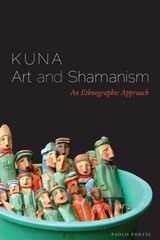 Kuna Art and Shamanism: An Ethnographic Approach
By Paolo Fortis
University of Texas Press, 2013 Known for their beautiful textile art, the Kuna of Panama have been scrutinized by anthropologists for decades. Perhaps surprisingly, this scrutiny has overlooked the magnificent Kuna craft of nuchukana—wooden anthropomorphic carvings—which play vital roles in curing and other Kuna rituals. Drawing on long-term fieldwork, Paolo Fortis at last brings to light this crucial cultural facet, illuminating not only Kuna aesthetics and art production but also their relation to wider social and cosmological concerns. Exploring an art form that informs birth and death, personhood, the dream world, the natural world, religion, gender roles, and ecology, Kuna Art and Shamanism provides a rich understanding of this society’s visual system, and the ways in which these groundbreaking ethnographic findings can enhance Amerindian scholarship overall. Fortis also explores the fact that to ask what it means for the Kuna people to carve the figure of a person is to pose a riddle about the culture’s complete concept of knowing. Also incorporating notions of landscape (islands, gardens, and ancient trees) as well as cycles of life, including the influence of illness, Fortis places the statues at the center of a network of social relationships that entangle people with nonhuman entities. As an activity carried out by skilled elderly men, who possess embodied knowledge of lifelong transformations, the carving process is one that mediates mortal worlds with those of immortal primordial spirits. Kuna Art and Shamanism immerses readers in this sense of unity and opposition between soul and body, internal forms and external appearances, and image and design.
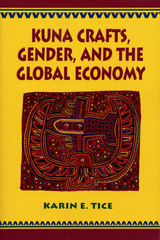 Kuna Crafts, Gender, and the Global Economy
By Karin E. Tice
University of Texas Press, 1995 Brightly colored and intricately designed, molas have become popular with buyers across the United States, Europe, and Japan, many of whom have never heard of the San Blas Kuna of Panama who make the fabric pictures that adorn the clothing, wall hangings, and other goods we buy. In this study, Karin Tice explores the impact of the commercialization of mola production on Kuna society, one of the most important, yet least studied, social changes to occur in San Blas in this century. She argues that far from being a cohesive force, commercialization has resulted in social differentiation between the genders and among Kuna women residing in different parts of the region. She also situates this political economic history within a larger global context of international trade, political intrigue, and ethnic tourism to offer insights concerning commercial craft production that apply far beyond the Kuna case. These findings, based on extensive ethnographic field research, constitute important reading for scholars and students of anthropology, women’s studies, and economics. They also offer an indigenous perspective on the twentieth-century version of Columbus’s landing—the arrival of a cruise ship bearing wealthy, souvenir-seeking tourists.
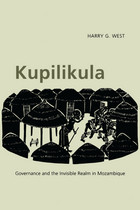 Kupilikula: Governance and the Invisible Realm in Mozambique
Harry G. West
University of Chicago Press, 2005 On the Mueda plateau in northern Mozambique, sorcerers are said to feed on their victims, sometimes "making" lions or transforming into lions to literally devour their flesh. When the ruling FRELIMO party subscribed to socialism, it condemned sorcery beliefs and counter-sorcery practices as false consciousness, but since undertaking neoliberal reform, the party—still in power after three electoral cycles—has "tolerated tradition," leaving villagers to interpret and engage with events in the idiom of sorcery. Now, when the lions prowl plateau villages ,suspected sorcerers are often lynched.
In this historical ethnography of sorcery, Harry G. West draws on a decade of fieldwork and combines the perspectives of anthropology and political science to reveal how Muedans expect responsible authorities to monitor the invisible realm of sorcery and to overturn or, as Muedans call it, "kupilikula" sorcerers' destructive attacks by practicing a constructive form of counter-sorcery themselves. Kupilikula argues that, where neoliberal policies have fostered social division rather than security and prosperity, Muedans have, in fact, used sorcery discourse to assess and sometimes overturn reforms, advancing alternative visions of a world transformed.
 The Kurbskii-Groznyi Apocrypha: the 17th-Century Genesis of the "Correspondence" Attributed to Prince A. M. Kurbskii and Tsar Ivan IV
Edward L. Keenan
Harvard University Press, 1971 For centuries the exchange of letters between Ivan the Terrible (1530-1584) and Prince Kurbskii, Muscovy's first notable defector, has been considered an authentic and important source for sixteenth-century Russian history. The Ivan portrayed in these letters has dominated posterity's perception of him and his time. But the provenance of the "Correspondence" has never been properly established.
Edward L. Keenan draws on all the tools of source study and literary criticism to demonstrate that the "Correspondence" is a forgery, and in fact was composed some decades later in the seventeenth century. He concentrates on the first letter of Kurbskii, which is the earliest of the letters as well as a source for the later ones, and concludes that it was written between 1623 and 1625 by Semen Ivanovich Shakhovskoi--a conclusion that will necessitate the re-evaluation of sixteenth-century Russian history as it has previously been written by scholars throughout the world.
Keenan discusses at length the implications of his discovery and sketches directions for future study, which will include a reconstruction of our conception of sixteenth- and seventeenth-century political thought, of Ivan's personality--indeed of the nature of his reign--and of the evolution of Muscovite state ideology.
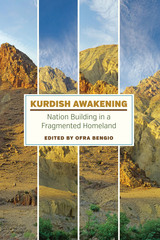 Kurdish Awakening: Nation Building in a Fragmented Homeland
Edited by Ofra Bengio
University of Texas Press, 2014 Kurdish Awakening examines key questions related to Kurdish nationalism and identity formation in Syria, Iraq, Iran, and Turkey. The world’s largest stateless ethnic group, Kurds have steadily grown in importance as a political power in the Middle East, particularly in light of the “Arab Spring.” As a result, Kurdish issues—political, cultural, and historical alike—have emerged as the subject of intense scholarly interest. This book provides fresh ways of understanding the historical and sociopolitical underpinnings of the ongoing Kurdish awakening and its already significant impact on the region. Rather than focusing on one state or angle, this anthology fills a gap in the literature on the Kurds by providing a panoramic view of the Kurdish homeland’s various parts. The volume focuses on aspects of Kurdish nationalism and identity formation not addressed elsewhere, including perspectives on literature, gender, and constitution making. Further, broad thematic essays include a discussion of the historical experiences of the Kurds from the time of their Islamization more than a millennium ago up until the modern era, a comparison of the Kurdish experience with other ethno-national movements, and a treatment of the role of tribalism in modern nation building. This collection is unique in its use of original sources in various languages. The result is an analytically rich portrayal that sheds light on the Kurds’ prospects and the challenges they confront in a region undergoing sweeping upheavals.
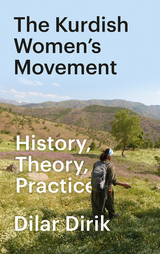 The Kurdish Women’s Movement: History, Theory, Practice
Dilar Dirik
Pluto Press, 2021 'One the foremost writers and participants in the Kurdish women's movement' - Harsha Walia
The Kurdish women's movement is at the heart of the most exciting revolutionary experiment in the world today: Rojava. Forged over decades of struggle, most recently in the fight against ISIS, Rojava embodies a radical commitment to ecology, democracy and gender equality. But while striking images of Kurdish women in desert fatigues proliferate, a true understanding of the women's movement remains elusive.
Taking apart the superficial and Orientalist frameworks that dominate, Dilar Dirik offers instead an empirically rich account of the women's movement in Kurdistan. Drawing on original research and ethnographic fieldwork, she surveys the movement's historical origins, ideological evolution, and political practice over the past forty years. Going beyond abstract ideas, Dirik locates the movement's culture and ideology in its concrete work for women's liberation and radical democracy.
Taking the reader from the guerrilla camps in the mountains to radical women's academies and self-organized refugee camps, the book invites readers around the world to engage with the revolution in Kurdistan, both theoretically and practically, as a vital touchstone in the wider struggle for a militant anti-fascist, anti-capitalist feminist internationalism.
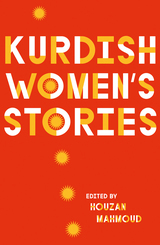 Kurdish Women's Stories
Houzan Mahmoud
Pluto Press, 2020 'A fascinating, inspiring journey' - Meredith Tax, author of A Road Unforeseen Kurdistan has had a tumultuous history, and the women who lived there have experienced life like no other. From Saddam Hussein’s reign of terror beginning in the 1960s, to the fight against ISIS today, violence, revolution, and questions around identity, agency, survival, and resistance have been at the forefront of women’s lives for decades. This book is a collection of these women’s stories written in their own words. Each story reveals a tapestry of experiences, including political activism under Saddam and armed resistance in Rojava’s PKK and YPG and Komala in Rojhalat. This is in addition to experiences of FGM and overcoming victimhood, life under extreme conservatism, as well as a look into the work of artists, poets, novelists, and performers whose work represents a complicated relationship with Kurdistan. These rich and nuanced insights come from a group of women from a nation without a state, who are now scattered across the world. Collectively, they take the reader on a journey that will inspire feminist, anti-fascist, and anti-racist people across the world.
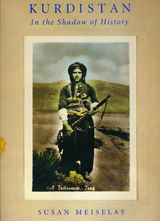 Kurdistan: In the Shadow of History, Second Edition
Susan Meiselas
University of Chicago Press, 2008 Kurdistan was erased from world maps after World War I, when the victorious powers carved up the Middle East, leaving the Kurds without a homeland. Today the Kurds, who live on land that straddles the borders of Turkey, Iran, Iraq, and Syria, are by far the largest ethnic group in the world without a state.
Renowned photographer Susan Meiselas entered northern Iraq after the 1991 Gulf War to record the effects of Saddam Hussein’s campaigns against Iraq’s Kurdish population. She joined Human Rights Watch in documenting the destruction of Kurdish villages (some of which Hussein had attacked with chemical weapons in 1988) and the uncovering of mass graves. Moved by her experiences there, Meiselas began work on a visual history of the Kurds. The result, Kurdistan: In the Shadow of History, gives form to the collective memory of the Kurds and creates from scattered fragments a vital national archive.
In addition to Meiselas’s own photographs, Kurdistan presents images and accounts by colonial administrators, anthropologists, missionaries, soldiers, journalists, and others who have traveled to Kurdistan over the last century, and, not to forget, by Kurds themselves. The book’s pictures, personal memoirs, government reports, letters, advertisements, and mapsprovide multiple layers of representation, juxtaposing different orders of historiographical evidence and memories, thus allowing the reader to discover voices of the Kurds that contest Western notions of them. In its layering of narratives—both textual and photographic—Kurdistan breaks new ground, expanding our understanding of how images can be used as a medium for historical and cultural representation. A crucial repository of memory for the Kurdish community both in exile and at home, this new edition appears at a time when the world’s attention has once again been drawn to the lands of this little-understood but historically consequential people.
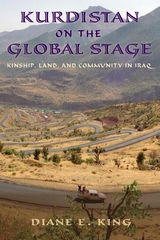 Kurdistan on the Global Stage: Kinship, Land, and Community in Iraq
King, Diane E
Rutgers University Press, 2014 Anthropologist Diane E. King has written about everyday life in the Kurdistan Region of Iraq, which covers much of the area long known as Iraqi Kurdistan. Following the overthrow of Saddam Hussein’s Ba’thist Iraqi government by the United States and its allies in 2003, Kurdistan became a recognized part of the federal Iraqi system. The Region is now integrated through technology, media, and migration to the rest of the world. Focusing on household life in Kurdistan’s towns and villages, King explores the ways that residents connect socially, particularly through patron-client relationships and as people belonging to gendered categories. She emphasizes that patrilineages (male ancestral lines) seem well adapted to the Middle Eastern modern stage and viceversa. The idea of patrilineal descent influences the meaning of refuge-seeking and migration as well as how identity and place are understood, how women and men interact, and how “politicking” is conducted. In the new Kurdistan, old values may be maintained, reformulated, or questioned. King offers a sensitive interpretation of the challenges resulting from the intersection of tradition with modernity. Honor killings still occur when males believe their female relatives have dishonored their families, and female genital cutting endures. Yet, this is a region where modern technology has spread and seemingly everyone has a mobile phone. Households may have a startling combination of illiterate older women and educated young women. New ideas about citizenship coexist with older forms of patronage. King is one of the very few scholars who conducted research in Iraq under extremely difficult conditions during the Saddam Hussein regime. How she was able to work in the midst of danger and in the wake of genocide is woven throughout the stories she tells. Kurdistan on the Global Stage serves as a lesson in field research as well as a valuable ethnography.
The Kurds in Iraq - Second Edition: The Past, Present and Future
Kerim Yildiz
Pluto Press, 2007 This new edition of The Kurds in Iraq brings the book fully up to date in the light of recent events in Iraq and the ever-present danger of civil war. Kerim Yildiz explores the impact of occupation and escalating violence. there is an entirely new chapter on Kirkuk, which continues to be of major strategic interest to the various powers in the region. There is also a new chapter on insurgency and sectarianism that examines the motivations behind the insurgency, the tactics that are used, and an outline of possible ways to deal with it.
The book is a unique account of the problems that all political groups face in bringing stability to the country. It explores Kurdish links to those political groups and their role in international relations in the broader sense. It should be required reading for policymakers and anyone interested in the current position of the Kurds in Iraq.
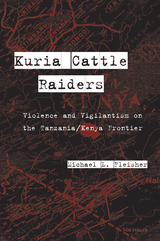 Kuria Cattle Raiders: Violence and Vigilantism on the Tanzania/Kenya Frontier
Michael L. Fleisher
University of Michigan Press, 2000 Kuria Cattle Raiders is about cattle raiding as practiced--both historically and in the present day--by the agro-pastoralist Kuria people, whose population straddles the border between Tanzania and Kenya. Based on field research conducted in the Tarime District lowlands of northern Tanzania, the book documents and analyzes an extraordinary transformation in the nature of Kuria cattle raiding that has occurred over the course of the past century. While in years past the raiding of other tribes and other Kuria clans was done for prestige and bridewealth cattle, today the practice is carried out by heavily armed multiclan and multiethnic gangs that are highly organized and cash market-oriented. This change, Michael Fleisher argues, is due to the penetration and evolution of the colonial economy into the region and the administrative policies of the post-colonial Tanzanian state.
The reciprocal raiding of cattle by pastoralists has a long and venerable history in East Africa, but there has been, until now, no book-length treatment of the practice, and, more importantly, no detailed case study of the newer, "modern" form of cattle raiding described here. In addition, the phenomenon of Kuria cattle raiding conveys significant implications for our understanding of informal economies and globalization processes.
Kuria Cattle Raiders engages issues of theoretical as well as practical significance for anthropologists, sociologists, criminologists, cultural ecologists, economic development agencies, and all those concerned with the pressing issues of globalization and rapid social and cultural change.
Michael L. Fleisher, a Post-Doctoral Research Fellow in the Department of Rangeland Resources, Utah State University, is currently engaged in a study of conflict among pastoralists in southern Ethiopia as part of a research project jointly administered by the University of Kentucky, Utah State University, and Cornell University under a grant from U.S.A.I.D.
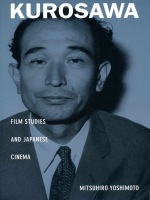 Kurosawa: Film Studies and Japanese Cinema
Mitsuhiro Yoshimoto
Duke University Press, 2000 The films of Akira Kurosawa have had an immense effect on the way the Japanese have viewed themselves as a nation and on the way the West has viewed Japan. In this comprehensive and theoretically informed study of the influential director’s cinema, Mitsuhiro Yoshimoto definitively analyzes Kurosawa’s entire body of work, from 1943’s Sanshiro Sugata to 1993’s Madadayo. In scrutinizing this oeuvre, Yoshimoto shifts the ground upon which the scholarship on Japanese cinema has been built and questions its dominant interpretive frameworks and critical assumptions. Arguing that Kurosawa’s films arouse anxiety in Japanese and Western critics because the films problematize Japan’s self-image and the West’s image of Japan, Yoshimoto challenges widely circulating clichés about the films and shows how these works constitute narrative answers to sociocultural contradictions and institutional dilemmas. While fully acknowledging the achievement of Kurosawa as a filmmaker, Yoshimoto uses the director’s work to reflect on and rethink a variety of larger issues, from Japanese film history, modern Japanese history, and cultural production to national identity and the global circulation of cultural capital. He examines how Japanese cinema has been “invented” in the discipline of film studies for specific ideological purposes and analyzes Kurosawa’s role in that process of invention. Demonstrating the richness of both this director’s work and Japanese cinema in general, Yoshimoto’s nuanced study illuminates an array of thematic and stylistic aspects of the films in addition to their social and historical contexts. Beyond aficionados of Kurosawa and Japanese film, this book will interest those engaged with cultural studies, postcolonial studies, cultural globalization, film studies, Asian studies, and the formation of academic disciplines.
Kurt Baschwitz: A Pioneer of Communication Studies and Social Psychology
Jaap van Ginneken
Amsterdam University Press, 2018 In this accessible, unique study of a forgotten but noteworthy figure, the author tells the story of the life of Kurt Baschwitz (1886—1968), a scholar who fled from the Nazis. He wrote six books, never translated into English, on four related themes: the press, propaganda, politics, and persecution. Baschwitz independently developed concepts that are now seen as key to communication science and social psychology, and the author places Baschwitz’s ideas in the wider context of his dramatic life and times.
Kurt Kren: Structural Films
Edited by Nicky Hamlyn, Simon Payne, and A. L. Rees
Intellect Books, 2016 Kurt Kren was a vital figure in Austrian avant-garde cinema of the postwar period. His structural films—often shot frame-by-frame following elaborately prescored charts and diagrams—have influenced filmmakers for decades, even as Kren himself remained a nomadic and obscure public figure. Kurt Kren, edited by Nicky Hamlyn, Simon Payne, and A. L. Rees, brings together interviews with Kren, film scores, and classic, out-of-print essays, alongside the reflections of contemporary academics and filmmakers, to add much-needed critical discussion of Kren’s legacy. Taken together, the collection challenges the canonical view of Kren that ignores his underground lineage and powerful, lyrical imagery.
 Kurt Schwitters: Space, Image, Exile
Megan R. Luke
University of Chicago Press, 2014 German artist Kurt Schwitters (1887–1948) is best known for his pioneering work in fusing collage and abstraction, the two most transformative innovations of twentieth-century art. Considered the father of installation art, Schwitters was also a theorist, a Dadaist, and a writer whose influence extends from Robert Rauschenberg and Eva Hesse to Thomas Hirschhorn. But while his early experiments in collage and installation from the interwar period have garnered much critical acclaim, his later work has generally been ignored. In the first book to fill this gap, Megan R. Luke tells the fascinating, even moving story of the work produced by the aging, isolated artist under the Nazi regime and during his years in exile. Combining new biographical material with archival research, Luke surveys Schwitters’s experiments in shaping space and the development of his Merzbau, describing his haphazard studios in Scandinavia and the United Kingdom and the smaller, quieter pieces he created there. She makes a case for the enormous relevance of Schwitters’s aesthetic concerns to contemporary artists, arguing that his later work provides a guide to new narratives about modernism in the visual arts. These pieces, she shows, were born of artistic exchange and shaped by his rootless life after exile, and they offer a new way of thinking about the history of art that privileges itinerancy over identity and the critical power of humorous inversion over unambiguous communication. Packed with images, Kurt Schwitters completes the narrative of an artist who remains a considerable force today.
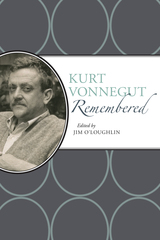 Kurt Vonnegut Remembered
Edited by Jim O'Loughlin
University of Alabama Press, 2019 A collection of reminiscences that illuminate the career and private life of the iconic author of 'Slaughterhouse-Five'
Kurt Vonnegut (1922–2007), who began his writing career working for popular magazines, held both literary aspirations and an attraction to genre fiction. His conspicuous refusal to respect literary boundaries was part of what made him a countercultural icon in the 1960s and 1970s. Vonnegut’s personal life was marked in large part by public success and private turmoil. Two turbulent marriages, his sudden adoption of his late sister’s four children (and the equally sudden removal of one of those children), and a mid-eighties suicide attempt all signaled the extent of Vonnegut’s inner troubles. Yet, he was a generous friend to many, maintaining close correspondences throughout his life.
Kurt Vonnegut Remembered gathers reminiscences—by those who knew him intimately, and from those met him only once—that span Vonnegut’s entire life. Among the anecdotes in this collection are remembrances from his immediate family, reflections from his comrades in World War II, and tributes from writers he worked with in Iowa City and from those who knew him when he was young. Editor Jim O’Loughlin offers biographical notes on Vonnegut’s relationship with each of these figures.
Since Vonnegut’s death, much has been written on his life and work, but this new volume offers a more generous view of his life, particularly his last years. In O’Loughlin’s introduction to the volume, he argues that we can locate and understand Vonnegut’s best self through his public persona, and that in his performance as the kind and humane figure that many of the speakers here knew him as, Vonnegut became a better person than he ever felt himself to be.
Kurt Wolff: A Portrait in Essays and Letters
Kurt Wolff
University of Chicago Press, 1991 Kurt Wolff (1887-1963) was a singular presence in the literary world of the twentieth century, a cultural force shaping modern literature itself and pioneering significant changes in publishing. During an intense, active career that spanned two continents and five decades, Wolff launched seven publishing houses and nurtured an extraordinary array of writers, among them Franz Kafka, Lou Andreas-Salomé, Boris Pasternak, Günter Grass, Robert Musil, Paul Valéry, Julian Green, Lampedusa, and Anne Morrow Lindbergh.
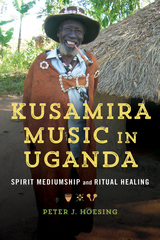 Kusamira Music in Uganda: Spirit Mediumship and Ritual Healing
Peter J. Hoesing
University of Illinois Press, 2021 A performance culture of illness and wellness In southern Uganda, ritual healing traditions called kusamira and nswezi rely on music to treat sickness and maintain well-being. Peter J. Hoesing blends ethnomusicological fieldwork with analysis to examine how kusamira and nswezi performance socializes dynamic processes of illness, wellness, and health. People participate in these traditions for reasons that range from preserving ideas to generating strategies that allow them to navigate changing circumstances. Indeed, the performance of kusamira and nswezi reproduces ideas that remain relevant for succeeding generations. Hoesing shows the potential of this social reproduction of well-being to shape development in a region where over 80 percent of the population relies on traditional healers for primary health care. Comprehensive and vivid with eyewitness detail, Kusamira Music in Uganda offers insight into important healing traditions and the overlaps between expressive culture and healing practices, the human and other-than-human, and Uganda's past and future.
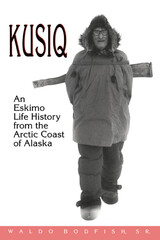 Kusiq: An Eskimo Life History from the Arctic Coast of Alaska.
Waldo Bodfish Sr.
University of Alaska Press, 1991 If you are a casual reader who wants an intriguing glimpse into Eskimo life, a novice oral historian who wants to know how it is done right, or a student of Alaska who wants an Inupiat perspective of the changes that swept the western Arctic this century, read Kusiq.
(Journal of the West)
A vivid 'inside' account of an observant Eskimo male who mastered much of the traditional subsistence technology and lore and who lived through the end of commercial whaling, the development and decline of introduced reindeer herding and the fur market, and through World War II and its aftermath. In its scope as well as in the presentation of historical, cultural, and linguistic context,Kusiq is far more extensive than [other] autobiographies.
(American Indian Culture and Research Journal)
Kusiq represents a new wave in literature, the expressions of cultural awakenings among native American cultures, the attempt to redefine the native world in written form, to recast history, a history for too long the domain of the white system.
(ARCTIC)
It would be difficult to find a better, more interesting first-person account of Eskimo life during the first half of this century. [It is] second in an ambitious series of oral histories developed by the University of Alaska Press.
(Scan-A-Book)
The collaborators for this book include William Schneider, curator of oral history at the Elmer E. Rasmuson Library, University of Alaska Fairbanks; Leona Kisautaq Okakok, manager of the Arctic Education Foundation at the Arctic Slope Regional Corporation; and James Mumigana Nageak, coordinator of bilingual and multicultural instruction at the North Slope Borough School District. Schneider recorded and compiled Bodfish's stories, while Okakok and Nageak, both Inupiaq Eskimo language specialists, contributed their skills in interviewing, translating, and clarifying Inupiaq concepts. The book contains twelve chapters of Bodfish's narrative, background and commentary by the collaborators, and information on pronunciation, personal names, genealogical relations, and place names.
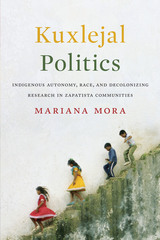 Kuxlejal Politics: Indigenous Autonomy, Race, and Decolonizing Research in Zapatista Communities
By Mariana Mora
University of Texas Press, 2017 Over the past two decades, Zapatista indigenous community members have asserted their autonomy and self-determination by using everyday practices as part of their struggle for lekil kuxlejal, a dignified collective life connected to a specific territory. This in-depth ethnography summarizes Mariana Mora’s more than ten years of extended research and solidarity work in Chiapas, with Tseltal and Tojolabal community members helping to design and evaluate her fieldwork. The result of that collaboration—a work of activist anthropology—reveals how Zapatista kuxlejal (or life) politics unsettle key racialized effects of the Mexican neoliberal state. Through detailed narratives, thick descriptions, and testimonies, Kuxlejal Politics focuses on central spheres of Zapatista indigenous autonomy, particularly governing practices, agrarian reform, women’s collective work, and the implementation of justice, as well as health and education projects. Mora situates the proposals, possibilities, and challenges associated with these decolonializing cultural politics in relation to the racialized restructuring that has characterized the Mexican state over the past twenty years. She demonstrates how, despite official multicultural policies designed to offset the historical exclusion of indigenous people, the Mexican state actually refueled racialized subordination through ostensibly color-blind policies, including neoliberal land reform and poverty alleviation programs. Mora’s findings allow her to critically analyze the deeply complex and often contradictory ways in which the Zapatistas have reconceptualized the political and contested the ordering of Mexican society along lines of gender, race, ethnicity, and class.
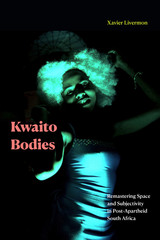 Kwaito Bodies: Remastering Space and Subjectivity in Post-Apartheid South Africa
Xavier Livermon
Duke University Press, 2020 In Kwaito Bodies Xavier Livermon examines the cultural politics of the youthful black body in South Africa through the performance, representation, and consumption of kwaito, a style of electronic dance music that emerged following the end of apartheid. Drawing on fieldwork in Johannesburg's nightclubs and analyses of musical performances and recordings, Livermon applies a black queer and black feminist studies framework to kwaito. He shows how kwaito culture operates as an alternative politics that challenges the dominant constructions of gender and sexuality. Artists such as Lebo Mathosa and Mandoza rescripted notions of acceptable femininity and masculinity, while groups like Boom Shaka enunciated an Afrodiasporic politics. In these ways, kwaito culture recontextualizes practices and notions of freedom within the social constraints that the legacies of colonialism, apartheid, and economic inequality place on young South Africans. At the same time, kwaito speaks to the ways in which these legacies reverberate between cosmopolitan Johannesburg and the diaspora. In foregrounding this dynamic, Livermon demonstrates that kwaito culture operates as a site for understanding the triumphs, challenges, and politics of post-apartheid South Africa.
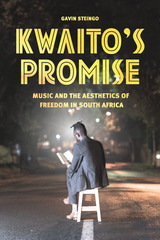 Kwaito's Promise: Music and the Aesthetics of Freedom in South Africa
Gavin Steingo
University of Chicago Press, 2016 In mid-1990s South Africa, apartheid ended, Nelson Mandela was elected president, and the country’s urban black youth developed kwaito—a form of electronic music (redolent of North American house) that came to represent the post-struggle generation. In this book, Gavin Steingo examines kwaito as it has developed alongside the democratization of South Africa over the past two decades. Tracking the fall of South African hope into the disenchantment that often characterizes the outlook of its youth today—who face high unemployment, extreme inequality, and widespread crime—Steingo looks to kwaito as a powerful tool that paradoxically engages South Africa’s crucial social and political problems by, in fact, seeming to ignore them.
Politicians and cultural critics have long criticized kwaito for failing to provide any meaningful contribution to a society that desperately needs direction. As Steingo shows, however, these criticisms are built on problematic assumptions about the political function of music. Interacting with kwaito artists and fans, he shows that youth aren’t escaping their social condition through kwaito but rather using it to expand their sensory realities and generate new possibilities. Resisting the truism that “music is always political,” Steingo elucidates a music that thrives on its radically ambiguous relationship with politics, power, and the state.
 Kwame Nkrumah: The Father of African Nationalism
Jeffrey S. Ahlman
Ohio University Press, 1998 The first African statesman to achieve world recognition was Kwame Nkrumah (1909-1972), who became president of the new Republic of Ghana in 1960. He campaigned ceaselessly for African solidarity and for the liberation of southern Africa from white settler rule. His greatest achievement was to win the right of black peoples in Africa to have a vote and to determine their own destiny. He turned a dream of liberation into a political reality. He was the leader of Ghana who urged Africa to shed the colonial yoke and who inspired black people everywhere to seek their freedom. This revised edition of Birmingham’s fine and accessible biography chronicles the public accomplishments of this extraordinary leader, who faced some of the century’s most challenging political struggles over colonial transition. African nationalism, and pan-Africanism. It also relates some of the personal trials of a complex individual. As a student in America in the late 1930s, Nkrumah, shy, disorganized, but ambitious and persistent, earned four degrees in ten years. For political training he then went to England. Nkrumah found writing difficult throughout his lifetime, but once back in his African homeland, with its oral heritage, Nkrumah blossomed as a charming conversationalist, a speechmaker, and eventually a visionary and inspiring leader. Nkrumah’s crusades were controversial, however, and in the 1960s he gradually lost his heroic stature both among his own people and among his fellow leaders. He lived his last years in exile. This remarkable life story, which touches on many of the issues facing modern Africa, will open a window of understanding for the general leader as well as for graduate and undergraduate classes. In this new edition, Birmingham also examines Nkrumah’s exile and provides insight into the image of Nkrumah that has emerged in the light of research recently published.
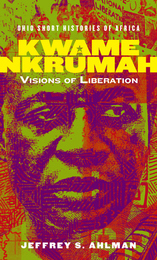 Kwame Nkrumah: Visions of Liberation
Jeffrey S. Ahlman
Ohio University Press, 2021 A new biography of Ghana’s Kwame Nkrumah, one of the most influential political figures in twentieth-century African history. As the first prime minister and president of the West African state of Ghana, Kwame Nkrumah helped shape the global narrative of African decolonization. After leading Ghana to independence in 1957, Nkrumah articulated a political vision that aimed to free the country and the continent—politically, socially, economically, and culturally—from the vestiges of European colonial rule, laying the groundwork for a future in which Africans had a voice as equals on the international stage. Nkrumah spent his childhood in the maturing Gold Coast colonial state. During the interwar and wartime periods he was studying in the United States. He emerged in the postwar era as one of the foremost activists behind the 1945 Manchester Pan-African Congress and the demand for an immediate end to colonial rule. Jeffrey Ahlman’s biography plots Nkrumah’s life across several intersecting networks: colonial, postcolonial, diasporic, national, Cold War, and pan-African. In these contexts, Ahlman portrays Nkrumah not only as an influential political leader and thinker but also as a charismatic, dynamic, and complicated individual seeking to make sense of a world in transition.
 Kwanzaa and Me: A Teacher’s Story
Vivian Gussin Paley
Harvard University Press, 1995 "All these white schools I've been sent to are racist," Sonya says. "I'd have done better in a black school. I was an outsider here." These are hard words for Vivian Paley, whose own kindergarten was one of Sonya's schools, the integrated classroom so lovingly and hopefully depicted by Paley in White Teacher. Confronted with the grown-up Sonya, now on her way to a black college, and with a chorus of voices questioning the fairness and effectiveness of integrated education, Paley sets out to discover the truth about the multicultural classroom from those who participate in it. This is an odyssey undertaken on the wings of conversation and storytelling in which every voice adds new meaning to the idea of belonging, really belonging, to a school culture. Here are black teachers and minority parents, immigrant families, a Native American educator, and the children themselves, whose stories mingle with the author's to create a candid picture of the successes and failures of the integrated classroom. As Paley travels the country listening to these stories, we see what lies behind recent moves toward self-segregation: an ongoing frustration with racism as well as an abiding need for a nurturing community. And yet, among these diverse voices, we hear again and again the shared dream of a classroom where no family heritage is obscured and every child's story enriches the life of the schoolhouse.
"It's all about dialogue, isn't it?" asks Lorraine, a black third-grade teacher whose story becomes a central motif. And indeed, it is the dialogue that prevails in this warmly provocative and deeply engaging book, as parents and teachers learn how they must talk to each other, and to their children, if every child is to secure a sense of self in the schoolroom, no matter what the predominant ethnic background. Vivian Paley offers these discoveries to readers as a starting point for their own journeys toward community and kinship in today's schools and tomorrow's culture.
Kyiv, Ukraine
Roman Adrian Cybriwsky
Amsterdam University Press, 2014 The unrest and violence in Ukraine shocked the world, and the region’s long-term future remains troublingly uncertain. Focusing on the difficulty of Kiev’s transition from socialism to market democracy, this book demonstrates how Ukraine reached this turbulent point. Roman Adrian Cybriwsky delves deeply into the changing social geography of the city, recent urban development, and critical problems such as official corruption, inequality, sex tourism, and the heedless destruction of the city’s historical architecture—all difficulties that have contributed incrementally to Ukrainian citizens’ anger against their government. This thoroughly revised edition offers the clearest picture we’ve had yet of what has happened—and what is likely still to come—in Ukraine.
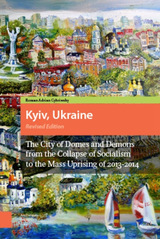 Kyiv, Ukraine - Revised Edition: The City of Domes and Demons from the Collapse of Socialism to the Mass Uprising of 2013-2014
Roman Adrian Cybriwsky
Amsterdam University Press, 2016 The unrest and violence in Ukraine in recent years shocked the world, and the region's long-term future remains troublingly uncertain. Focusing on the difficulty of Kiev's transition from socialism to market democracy, this book demonstrates how Ukraine reached this turbulent point. Roman Adrian Cybriwsky delves deeply into the changing social geography of the city, recent urban development, and critical problems such as official corruption, inequality, sex tourism, and the heedless destruction of the city's historical architecture - all difficulties that have contributed incrementally to Ukrainian citizens' anger against their government. This thoroughly revised edition brings Cybriwsky's account of events and their ramifications fully up to date, offering the clearest picture we've had yet of what has happened - and what is likely still to come - in Ukraine.
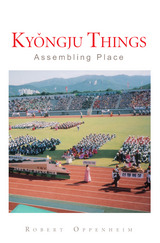 Kyongju Things: Assembling Place
Robert Oppenheim
University of Michigan Press, 2008 Kyongju is South Korea's preeminent "culture city," an urban site rich with archaeological wonders that residents compare to those of Nara, Xian, and Rome. By examining these ancient objects in relation to the controversies that engulfed South Korea's high-speed railway line when it was first proposed in the 1990s, Kyongju Things offers a grounded and theoretically sophisticated account of South Korean development and citizenship in the last quarter of the twentieth century. Its sensitivity to issues of place, knowledge, and cultural heritage and its innovative use of network theory will be of interest to a wide range of scholars in anthropology, Asian studies, the history of science and technology, cultural geography, urban planning, and political science. Robert Oppenheim is Assistant Professor of Asian Studies at the University of Texas at Austin. "A tale of South Korea's new politics involving antiquarians, weekend hikers, activists, and entrepreneurs, told with wit and theoretical sophistication."
---Laurel Kendall, Curator, Division of Anthropology, American Museum of Natural History "In Kyongju Things, Robert Oppenheim employs an innovative theoretical blend to insightfully illuminate the interactions of agency and objects in the making of a 'place.'"
---Roger L. Janelli, Professor Emeritus, Department of East Asian Languages and Cultures and Department of Folklore and Ethnomusicology, Indiana University "Kyongju Things is responsible, pathbreaking, and ambitious, with a stunning and welcoming introduction . . . Oppenheim calls upon a theoretical tool kit that allows him to productively re-think place, locality, technology, things, and subjectivity in ways that really do challenge the existing scholarship on South Korea. Kyongju Things will make a splash in Korean studies."
---Nancy Abelmann, Associate Professor of Anthropology, University of Illinois at Urbana-Champaign, and author of Echoes of the Past, Epics of Dissent: A South Korean Social Movement
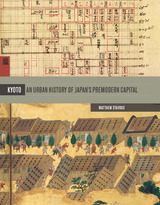 Kyoto: An Urban History of Japan's Premodern Capital
Matthew Stavros
University of Hawaii Press, 2014 Kyoto was Japan’s political and cultural capital for more than a millennium before the dawn of the modern era. Until about the fifteenth century, it was also among the world’s largest cities and, as the eastern terminus of the Silk Road, it was a place where the political, artistic, and religious currents of Asia coalesced and flourished. Despite these and many other traits that make Kyoto a place of both Japanese and world historical significance, the physical appearance of the premodern city remains largely unknown. Through a synthesis of textual, pictorial, and archeological sources, this work attempts to shed light on Kyoto’s premodern urban landscape with the aim of opening up new ways of thinking about key aspects of premodern Japanese history.
The book begins with an examination of Kyoto’s highly idealized urban plan (adapted from Chinese models in the eighth century) and the reasons behind its eventual failure. The formation of the suburbs of Kamigyō and Shimogyō is compared to the creation of large exurban temple-palace complexes by retired emperors from the late eleventh century. Each, it is argued, was a material manifestation of the advancement of privatized power that inspired a medieval discourse aimed at excluding “outsiders.” By examining this discourse, a case is made that medieval power holders, despite growing autonomy, continued to see the emperor and classical state system as the ultimate sources of political legitimacy. This sentiment was shared by the leaders of the Ashikaga shogunate, who established their headquarters in Kyoto in 1336. The narrative examines how these warrior leaders interacted with the capital’s urban landscape, revealing a surprising degree of deference to classical building protocols and urban codes. Remaining chapters look at the dramatic changes that took place during the Age of Warring States (1467–1580s) and Kyoto’s postwar revitalization under the leadership of Oda Nobunaga and Toyotomi Hideyoshi. Nobunaga’s construction of Nijō Castle in 1569 transformed Kyoto’s fundamental character and, as Japan’s first castle town, it set an example soon replicated throughout the archipelago. In closing, the book explores how Hideyoshi—like so many before him, yet with much greater zeal—used monumentalism to co-opt and leverage the authority of Kyoto’s traditional institutions.
Richly illustrated with original maps and diagrams, Kyoto is a panoramic examination of space and architecture spanning eight centuries. It narrates a history of Japan’s premodern capital relevant to the fields of institutional history, material culture, art and architectural history, religion, and urban planning. Students and scholars of Japan will be introduced to new ways of thinking about old historical problems while readers interested in the cities and architecture of East Asia and beyond will benefit from a novel approach that synthesizes a wide variety of sources.
Kyoto’s Renaissance: Ancient Capital for Modern Japan
John Breen
Amsterdam University Press, 2020 Draws on archive of material, a first in English to take an in-depth look at Kyoto’s modern transformation – its reinvention after ‘collapse’ (Meiji Restoration) and relocation of the imperial court to Tokyo. Includes: introduction, chapters on notable historical elements that sustain Kyoto as a quintessentially modern ‘ancient capital’ today.
|
|



